
-
 Superb Edo pictures illustrating dances (Odori keiyô Edo-e no sakae): Interior of an imaginary theater with a performance of Shibaraku 「踊形容江戸絵栄」. Artist: Utagawa Kunisada [歌川 国貞] a.k.a. Utagawa Toyokuni III [三代歌川豊国] (Japanese, 1786 – 1865). Publisher: Nōshūya Yasubei (Japanese, fl. c. 1851 – 1870). Year: 1858 (Ansei 5), 7th month. Size: Vertical ôban triptych; 36.9 x 75.7 cm. Signed: 一陽斎雛獅豊国筆(年玉印) – Ichiyôsai Hinashi Toyokuni ga (on left sheet only). Censor's seal: Horse 7 [午七 彫師]. Subject: Shibaraku. Ref.: MFA impression: 11.44263a-c; Robert Schaap. Kunisada (2016), p. 101 [LIB-1212.2017]. Ref.: [LIB-1197.2016] Arendie and Henk Herwig. Heroes of the kabuki stage: an introduction to kabuki with retellings of famous plays, illustrated by woodblock prints. — Amsterdam: Hotei Publishing, 2004; p. 38.
Superb Edo pictures illustrating dances (Odori keiyô Edo-e no sakae): Interior of an imaginary theater with a performance of Shibaraku 「踊形容江戸絵栄」. Artist: Utagawa Kunisada [歌川 国貞] a.k.a. Utagawa Toyokuni III [三代歌川豊国] (Japanese, 1786 – 1865). Publisher: Nōshūya Yasubei (Japanese, fl. c. 1851 – 1870). Year: 1858 (Ansei 5), 7th month. Size: Vertical ôban triptych; 36.9 x 75.7 cm. Signed: 一陽斎雛獅豊国筆(年玉印) – Ichiyôsai Hinashi Toyokuni ga (on left sheet only). Censor's seal: Horse 7 [午七 彫師]. Subject: Shibaraku. Ref.: MFA impression: 11.44263a-c; Robert Schaap. Kunisada (2016), p. 101 [LIB-1212.2017]. Ref.: [LIB-1197.2016] Arendie and Henk Herwig. Heroes of the kabuki stage: an introduction to kabuki with retellings of famous plays, illustrated by woodblock prints. — Amsterdam: Hotei Publishing, 2004; p. 38.
-
 Kabuki actor: Matsumoto Kōshirō V [五代目松本幸四郎] (Japanese, 1764-1838); other names: Ichikawa Komazō III, Ichikawa Sumizō I. Role: Nikki Danjo (仁木弾正): "Evil retainer Nikki Danjo who plots to overthrow his lord in the play Precious incense and the bush clover of Sendai (Meiboku sendai hagi)" [R. Kruml]. Artist: Utagawa Kunisada [歌川 国貞] a.k.a. Utagawa Toyokuni III [三代歌川豊国] (Japanese, 1786 – 1865). Block cutter: Horikō (Kiyomizu) Ryūzō [彫工 柳三]. Publisher: Ebisuya Shoshichi [恵比寿屋庄七], Kinshōdō (Japanese, fl. c. 1846 – 1883). Year: 1863 (Bunkyū 3), 7th month. Size: Vertical ōban, hōsho paper. Signed: Nanajuhassai (aged seventy-eight) Toyokuni ga within toshidama cartouche. Censor’s seal: date-aratame. This print is from a series of portraits that Kunisada undertook very late in life and has been named Kinshodo-ban yakusha okubi-e (Kinshodo’s Large-Head Actor Portraits) in reference to the publisher, Ebisuya Shochochi of Kinshodo. The series depicted great actors in their famous roles from the past and present. Ref.: (1) [LIB-1212.2017] Robert Schaap. Kunisada: Imaging, drama and beauty. — Leiden: Hotei Publishing, 2016, p. 118 and 167 (№ 42):
Kabuki actor: Matsumoto Kōshirō V [五代目松本幸四郎] (Japanese, 1764-1838); other names: Ichikawa Komazō III, Ichikawa Sumizō I. Role: Nikki Danjo (仁木弾正): "Evil retainer Nikki Danjo who plots to overthrow his lord in the play Precious incense and the bush clover of Sendai (Meiboku sendai hagi)" [R. Kruml]. Artist: Utagawa Kunisada [歌川 国貞] a.k.a. Utagawa Toyokuni III [三代歌川豊国] (Japanese, 1786 – 1865). Block cutter: Horikō (Kiyomizu) Ryūzō [彫工 柳三]. Publisher: Ebisuya Shoshichi [恵比寿屋庄七], Kinshōdō (Japanese, fl. c. 1846 – 1883). Year: 1863 (Bunkyū 3), 7th month. Size: Vertical ōban, hōsho paper. Signed: Nanajuhassai (aged seventy-eight) Toyokuni ga within toshidama cartouche. Censor’s seal: date-aratame. This print is from a series of portraits that Kunisada undertook very late in life and has been named Kinshodo-ban yakusha okubi-e (Kinshodo’s Large-Head Actor Portraits) in reference to the publisher, Ebisuya Shochochi of Kinshodo. The series depicted great actors in their famous roles from the past and present. Ref.: (1) [LIB-1212.2017] Robert Schaap. Kunisada: Imaging, drama and beauty. — Leiden: Hotei Publishing, 2016, p. 118 and 167 (№ 42): Ref.: (1) [LIB-1197.2016] Arendie and Henk Herwig. Heroes of the kabuki stage: an introduction to kabuki with retellings of famous plays, illustrated by woodblock prints. — Amsterdam: Hotei Publishing, 2004; pp. 243-249.
Ref.: (1) [LIB-1197.2016] Arendie and Henk Herwig. Heroes of the kabuki stage: an introduction to kabuki with retellings of famous plays, illustrated by woodblock prints. — Amsterdam: Hotei Publishing, 2004; pp. 243-249.


-
 Bandō Mitsugorō III as Daihanji Kiyozumi and Arashi Koroku IV as Koganosuke in kabuki play Imoseyama, an example of womanly virtue (Imoseyama onna teikin). 大判事清澄 坂東三津五郎」(三代)・「久我之助 嵐小六」(四代) Artist: Shunkōsai Hokushū [春好斎北洲] (Japanese, fl. 1802 – 1832) Year: 1821 (3rd month). MFA description: “The Kabuki play Mount Imo and Mount Se: An Exemplary Tale of Womanly Virtue (Imoseyama onna teikin), originally based on a puppet play, is set in ancient Japan when the Soga clan served as regents to the emperor. Two children, Hinadori and Koganosuke, of rival court families, are held hostage under orders from the tyrant Soga no Iruka to ensure their families do not revolt. The children fall in love, but rather than create conflicts for their families they each vow to die by suicide. When the parents learn of their plans, they resolve to cooperate to overthrow Iruka. Here Koganosuke and his father Kiyozumi are shown; a companion sheet on the left would have shown Hinadori and her mother Sadaka.” The play Imoseyama, an example of womanly virtue (Imoseyama onna teikin), was staged at Osaka's Kado Shibai (Kadoza, Kado Gekijô, Kado no Shibai) from 3/1821. According to Herwig, it is the right sheet of a diptych (see below). MFA Accession number: 2011.128 Kabuki actors: Bandō Mitsugorō III [三代目 坂東 三津五郎] (Japanese, 1775 – 1831); other names: Bandō Minosuke I, Morita Kanjirô II, Bandō Mitahachi I, Bandō Minosuke I, Bandō Mitahachi I. Arashi Koroku IV [四代目嵐小六] (Japanese, 1783 – 1826)
Bandō Mitsugorō III as Daihanji Kiyozumi and Arashi Koroku IV as Koganosuke in kabuki play Imoseyama, an example of womanly virtue (Imoseyama onna teikin). 大判事清澄 坂東三津五郎」(三代)・「久我之助 嵐小六」(四代) Artist: Shunkōsai Hokushū [春好斎北洲] (Japanese, fl. 1802 – 1832) Year: 1821 (3rd month). MFA description: “The Kabuki play Mount Imo and Mount Se: An Exemplary Tale of Womanly Virtue (Imoseyama onna teikin), originally based on a puppet play, is set in ancient Japan when the Soga clan served as regents to the emperor. Two children, Hinadori and Koganosuke, of rival court families, are held hostage under orders from the tyrant Soga no Iruka to ensure their families do not revolt. The children fall in love, but rather than create conflicts for their families they each vow to die by suicide. When the parents learn of their plans, they resolve to cooperate to overthrow Iruka. Here Koganosuke and his father Kiyozumi are shown; a companion sheet on the left would have shown Hinadori and her mother Sadaka.” The play Imoseyama, an example of womanly virtue (Imoseyama onna teikin), was staged at Osaka's Kado Shibai (Kadoza, Kado Gekijô, Kado no Shibai) from 3/1821. According to Herwig, it is the right sheet of a diptych (see below). MFA Accession number: 2011.128 Kabuki actors: Bandō Mitsugorō III [三代目 坂東 三津五郎] (Japanese, 1775 – 1831); other names: Bandō Minosuke I, Morita Kanjirô II, Bandō Mitahachi I, Bandō Minosuke I, Bandō Mitahachi I. Arashi Koroku IV [四代目嵐小六] (Japanese, 1783 – 1826)
Ref.: [LIB-1197.2016] Arendie and Henk Herwig. Heroes of the kabuki stage: an introduction to kabuki with retellings of famous plays, illustrated by woodblock prints. — Amsterdam: Hotei Publishing, 2004; p. 72:
Ref: [LIB-2973.2022] Ukiyo-e: A journey through the Floating World / Exhibition catalogue (Japan, Jan-Jul 2014). — The Yomiuri Shimbun, 2014; № 358, p. 226. "Bandō Mitsugorō III as Grand arbiter Kiyosumi and Arashi Koroku IV as Koganosuke":
-
 Okon's Lover Fukuoka Mitsugi, from the series Mirror of Virtuous Women (Teijo misao kagami)「てい女 美作保鏡 おこん 福岡貢」. Artist: Utagawa Kuniyoshi [歌川 國芳] (Japanese, 1798 – 1861). Publisher: Kojimaya Jūbei [小嶋屋重兵衛] (Japanese, fl. c. 1797 – 1869). Year: 1843–47 (Tenpô 14–Kôka 4). Signed: 一勇斎国芳画 – Ichiyûsai Kuniyoshi ga. Censor's seal: Watari. Size: Vertical ôban; 36.8 x 25.6 cm Ref.: MFA № 11.16085.
Okon's Lover Fukuoka Mitsugi, from the series Mirror of Virtuous Women (Teijo misao kagami)「てい女 美作保鏡 おこん 福岡貢」. Artist: Utagawa Kuniyoshi [歌川 國芳] (Japanese, 1798 – 1861). Publisher: Kojimaya Jūbei [小嶋屋重兵衛] (Japanese, fl. c. 1797 – 1869). Year: 1843–47 (Tenpô 14–Kôka 4). Signed: 一勇斎国芳画 – Ichiyûsai Kuniyoshi ga. Censor's seal: Watari. Size: Vertical ôban; 36.8 x 25.6 cm Ref.: MFA № 11.16085. -
 Artist: Katsukawa Shunkō [勝川 春好] (Japanese, 1743 – 1812).
Artist: Katsukawa Shunkō [勝川 春好] (Japanese, 1743 – 1812).Actor: Matsumoto Kōshirō IV [[松本幸四郎]; other names: Omegawa Kyōjūrō, Ichikawa Komazō II, Ichikawa Somegorô I, Ichikawa Takejūrō, Segawa Kinji, Segawa Kingo] (Japanese, 1737 – 1802).
Signed: Shunkō ga. Size: Hosoban; 14 x 33 cm. SOLD -
 Artist (attributed, no signature): Suzuki Harunobu [鈴木 春信] (Japanese, c. 1725 – 1770). The title is taken from [LIB-1478.2013] Gian Carlo Calza, Stefania Piotti. Poem of the pillow and other stories. — Phaidon Press, 2010; pp. 148-9. Alternative title: Man sucking woman's breast and a cat sitting under a bonsai tree. The open book beside the couple reads 子春 (Koharu). Woodblock print from the series Mirror Picture of Japan (Wakoku kagami); Size: Horizontal chuban; 21 x 26 cm.
Artist (attributed, no signature): Suzuki Harunobu [鈴木 春信] (Japanese, c. 1725 – 1770). The title is taken from [LIB-1478.2013] Gian Carlo Calza, Stefania Piotti. Poem of the pillow and other stories. — Phaidon Press, 2010; pp. 148-9. Alternative title: Man sucking woman's breast and a cat sitting under a bonsai tree. The open book beside the couple reads 子春 (Koharu). Woodblock print from the series Mirror Picture of Japan (Wakoku kagami); Size: Horizontal chuban; 21 x 26 cm. -
 Utagawa Kunisada [歌川 国貞]; a.k.a. Utagawa Toyokuni III [三代歌川豊国] (Japanese, 1786 – 1865). Signed: Toyokuni ga [豊国 画] in a red toshidama cartouche. Publisher: Mikawaya Heiroku [三川屋平六] (Japanese, fl. c. 1848 – 1856); seal: Mihei [三平] (Marks 11-016 | 325a) Block carver: Yokokawa Takejirō [横川竹二郎] (Japanese, fl. 1845 – 1863), seal: 彫竹 – Hori Take. Date seal and aratame censor seal: [辰正] Ansei 3, 1st month (1856). Inscriptions: Right cartouche: Three good fortunes of the present day [当世三福対] (Tosei sambuku tsui) Center cartouche: Ubuge no Kintaro [産毛の金太郎] (うぶげのきんたろう) According to Horst Graebner, the play is Tomigaoka koi no Yamabiraki (or Tomioka Koi no Yamabiraki [富岡戀山開], according to kabuki21.com, common title Ninin Shinbē [二人新兵衛]); Kintarō might be Nakamura Fukusuke I [中村福助], the female role might be Mikuni Kojorō [三国小女郎] (or Mikuni no Kojorō). Nakamura Shikan IV [中村芝翫] (Japanese, 1831 – 1899); other names: Nakamura Fukusuke I, Nakamura Masanosuke I, Nakamura Komasaburō, Nakamura Tamatarō I.
Utagawa Kunisada [歌川 国貞]; a.k.a. Utagawa Toyokuni III [三代歌川豊国] (Japanese, 1786 – 1865). Signed: Toyokuni ga [豊国 画] in a red toshidama cartouche. Publisher: Mikawaya Heiroku [三川屋平六] (Japanese, fl. c. 1848 – 1856); seal: Mihei [三平] (Marks 11-016 | 325a) Block carver: Yokokawa Takejirō [横川竹二郎] (Japanese, fl. 1845 – 1863), seal: 彫竹 – Hori Take. Date seal and aratame censor seal: [辰正] Ansei 3, 1st month (1856). Inscriptions: Right cartouche: Three good fortunes of the present day [当世三福対] (Tosei sambuku tsui) Center cartouche: Ubuge no Kintaro [産毛の金太郎] (うぶげのきんたろう) According to Horst Graebner, the play is Tomigaoka koi no Yamabiraki (or Tomioka Koi no Yamabiraki [富岡戀山開], according to kabuki21.com, common title Ninin Shinbē [二人新兵衛]); Kintarō might be Nakamura Fukusuke I [中村福助], the female role might be Mikuni Kojorō [三国小女郎] (or Mikuni no Kojorō). Nakamura Shikan IV [中村芝翫] (Japanese, 1831 – 1899); other names: Nakamura Fukusuke I, Nakamura Masanosuke I, Nakamura Komasaburō, Nakamura Tamatarō I. -
 Utagawa Kunisada [歌川 国貞]; a.k.a. Utagawa Toyokuni III [三代歌川豊国] (Japanese, 1786 – 1865). Signed: Toyokuni ga [豊国 画] in a yellow toshidama cartouche. Publisher: Unknown, seal [久] Kyū (Japanese, fl. c. 1851 – 1861); (Marks 07-023 | U176a, possibly Sagamia Kyūzō). Date seal and double nanushi censor seals: Fuku & Muramatsu, Kaei 6, 2nd month (2/1853). Inscription in a red cartouche: Purple of Edo // Purple of the Bay Capital [江都むらさき] (Edo Murasaki), alluding to Murasaki Shikibu [紫 式部] (Japanese, c. 973/8 – c. 1014/31), the author of Genji Monogatari [源氏物語] (The Tale of Genji), a Heian period novel which was the source of a parody Nise Murasaki Inaka Genji [偐紫田舎源氏] (Fake Murasaki’s Rustic Genji) by Ryutei Tanehiko [柳亭種彦] (Japanese, 1783 – 1842). According to Horst Graebner: The actor is most probably Iwai Kumesaburō III. Iwai Hanshirō VIII [岩井半四郎] (Japanese, 1829 – 1882); other names: Iwai Shijaku II, Iwai Kumesaburō III [岩井粂三郎], Iwai Hisajirō II. One of the series of Kunisada's fan prints in this collection:
Utagawa Kunisada [歌川 国貞]; a.k.a. Utagawa Toyokuni III [三代歌川豊国] (Japanese, 1786 – 1865). Signed: Toyokuni ga [豊国 画] in a yellow toshidama cartouche. Publisher: Unknown, seal [久] Kyū (Japanese, fl. c. 1851 – 1861); (Marks 07-023 | U176a, possibly Sagamia Kyūzō). Date seal and double nanushi censor seals: Fuku & Muramatsu, Kaei 6, 2nd month (2/1853). Inscription in a red cartouche: Purple of Edo // Purple of the Bay Capital [江都むらさき] (Edo Murasaki), alluding to Murasaki Shikibu [紫 式部] (Japanese, c. 973/8 – c. 1014/31), the author of Genji Monogatari [源氏物語] (The Tale of Genji), a Heian period novel which was the source of a parody Nise Murasaki Inaka Genji [偐紫田舎源氏] (Fake Murasaki’s Rustic Genji) by Ryutei Tanehiko [柳亭種彦] (Japanese, 1783 – 1842). According to Horst Graebner: The actor is most probably Iwai Kumesaburō III. Iwai Hanshirō VIII [岩井半四郎] (Japanese, 1829 – 1882); other names: Iwai Shijaku II, Iwai Kumesaburō III [岩井粂三郎], Iwai Hisajirō II. One of the series of Kunisada's fan prints in this collection: -
 Utagawa Kunisada [歌川 国貞]; a.k.a. Utagawa Toyokuni III [三代歌川豊国] (Japanese, 1786 – 1865). Signed: Toyokuni ga [豊国 画] in a yellow toshidama cartouche. Publisher: Unknown, seal [久] Kyū (Japanese, fl. c. 1851 – 1861); (Marks 07-023 | U176a, possibly Sagamia Kyūzō). Date seal and double nanushi censor seals: Fuku & Muramatsu, Kaei 6, 2nd month (2/1853). Inscription in a red cartouche: (Purple of Edo // Purple of the Bay Capital) [江都むらさき] (Edo Murasaki), alluding to Murasaki Shikibu [紫 式部] (Japanese, c. 973/8 – c. 1014/31), the author of Genji Monogatari [源氏物語] (The Tale of Genji), a Heian period novel which was the source of a parody Nise Murasaki Inaka Genji [偐紫田舎源氏] (Fake Murasaki’s Rustic Genji) by Ryutei Tanehiko [柳亭種彦] (Japanese, 1783 – 1842). According to Horst Graebner: The actor is most probably Onoe Baikō IV [四代目尾上菊五郞] Onoe Kikugorō IV [四代目 尾上菊五郎] (Japanese, 1808 – 1860); other names: Onoe Baikō IV, Onoe Eizaburō III, Onoe Kikue, Nakamura Tatsuzō, Nakamura Kachō. One of the series of Kunisada's fan prints in this collection:
Utagawa Kunisada [歌川 国貞]; a.k.a. Utagawa Toyokuni III [三代歌川豊国] (Japanese, 1786 – 1865). Signed: Toyokuni ga [豊国 画] in a yellow toshidama cartouche. Publisher: Unknown, seal [久] Kyū (Japanese, fl. c. 1851 – 1861); (Marks 07-023 | U176a, possibly Sagamia Kyūzō). Date seal and double nanushi censor seals: Fuku & Muramatsu, Kaei 6, 2nd month (2/1853). Inscription in a red cartouche: (Purple of Edo // Purple of the Bay Capital) [江都むらさき] (Edo Murasaki), alluding to Murasaki Shikibu [紫 式部] (Japanese, c. 973/8 – c. 1014/31), the author of Genji Monogatari [源氏物語] (The Tale of Genji), a Heian period novel which was the source of a parody Nise Murasaki Inaka Genji [偐紫田舎源氏] (Fake Murasaki’s Rustic Genji) by Ryutei Tanehiko [柳亭種彦] (Japanese, 1783 – 1842). According to Horst Graebner: The actor is most probably Onoe Baikō IV [四代目尾上菊五郞] Onoe Kikugorō IV [四代目 尾上菊五郎] (Japanese, 1808 – 1860); other names: Onoe Baikō IV, Onoe Eizaburō III, Onoe Kikue, Nakamura Tatsuzō, Nakamura Kachō. One of the series of Kunisada's fan prints in this collection: -
 Artist: Utagawa Kunisada [歌川 国貞] a.k.a. Utagawa Toyokuni III [三代歌川豊国] (Japanese, 1786 – 1865). Block cutter: Yokokawa Takejirō [横川竹二郎] (Japanese, fl. 1845 – 1863), seal Hori Take [彫竹]. Publisher: Ibaya Senzaburō [伊場屋仙三郎] (Japanese, fl. C. 1845 – 1847). Title: Book of an incoming ship [入船帳] (Irifune-chō). Series: Comparison of Eight Books of Proficiency and Eloquence [口も手も美立八帳] (Kuchimo temo mitate hatchō). Date seal and aratame censor seal: 1856 (Ansei 3). Signed: Toyokuni ga in toshidama cartouche. Media: Untrimmed fan print (uchiwa-e), 231 x 300 mm. Provenance: The Collection of Paul F. Walter, Christie's, New York, 2017, lot 341; sold together with 5 other fan prints for $25,000. Before: Israel Goldman, Japanese Prints, Catalogue 11, 2005, no. 37. Ref: [LIB-1693.2018] The Collection of Paul Walter. — NY: Christie's, 2017, p. 363. Ref: Israel Goldman, Catalogue 2018, № 51: "Utagawa Kunisada (1786-1865) A Beauty Seated in a Boat. From the series Mitate hatcho (A Parody of Eight Books). 1856. Fan print. 23.3 x 30 cm. Provenance: Israel Goldman, Japanese Prints, Catalogue 11, 2005, no. 37, The Collection of Paul F. Walter, Christie's, New York, 2017, lot 341. Fine impression, colour and condition. The title contains the saying: “Kuchi mo hatcho te mo hatcho (As quick with one’s hand as one’s tongue)." Special thanks to Horst Graebner for the detailed description.
Artist: Utagawa Kunisada [歌川 国貞] a.k.a. Utagawa Toyokuni III [三代歌川豊国] (Japanese, 1786 – 1865). Block cutter: Yokokawa Takejirō [横川竹二郎] (Japanese, fl. 1845 – 1863), seal Hori Take [彫竹]. Publisher: Ibaya Senzaburō [伊場屋仙三郎] (Japanese, fl. C. 1845 – 1847). Title: Book of an incoming ship [入船帳] (Irifune-chō). Series: Comparison of Eight Books of Proficiency and Eloquence [口も手も美立八帳] (Kuchimo temo mitate hatchō). Date seal and aratame censor seal: 1856 (Ansei 3). Signed: Toyokuni ga in toshidama cartouche. Media: Untrimmed fan print (uchiwa-e), 231 x 300 mm. Provenance: The Collection of Paul F. Walter, Christie's, New York, 2017, lot 341; sold together with 5 other fan prints for $25,000. Before: Israel Goldman, Japanese Prints, Catalogue 11, 2005, no. 37. Ref: [LIB-1693.2018] The Collection of Paul Walter. — NY: Christie's, 2017, p. 363. Ref: Israel Goldman, Catalogue 2018, № 51: "Utagawa Kunisada (1786-1865) A Beauty Seated in a Boat. From the series Mitate hatcho (A Parody of Eight Books). 1856. Fan print. 23.3 x 30 cm. Provenance: Israel Goldman, Japanese Prints, Catalogue 11, 2005, no. 37, The Collection of Paul F. Walter, Christie's, New York, 2017, lot 341. Fine impression, colour and condition. The title contains the saying: “Kuchi mo hatcho te mo hatcho (As quick with one’s hand as one’s tongue)." Special thanks to Horst Graebner for the detailed description. -
 Artist: Utagawa Kunisada [歌川 国貞] a.k.a. Utagawa Toyokuni III [三代歌川豊国] (Japanese, 1786 – 1865). Signed: Kunisada ga [国貞画] in a red double-gourd cartouche. Publisher: Iseya Sōemon [伊勢屋惣右衛門] (Japanese, c. 1776 – 1862). Date seal and kiwame censor seal: 1840 (Tenpō 11). Media: Untrimmed fan print (uchiwa-e), 227 x 293 mm. Title: Benzaiten Shrine at Honjō Block One [ひとつ目乃弁天] (Hitotsume no Benten). Provenance: The Collection of Paul F. Walter, Christie's, New York, 2017, lot 341; sold together with 5 other fan prints for $25,000. Before: Christie's, New York, 1997, lot 93 ($5,520). Ref: [LIB-1693.2018] The Collection of Paul Walter. — NY: Christie's, 2017, p. 363. Ref: Israel Goldman, Catalogue 2018, № 31: "Utagawa Kunisada (1786-1865) A Woman Reading a Letter by the Light of a Lantern. Hitotsume no Benten (One-eyed Benten). 1840. Fan print. Provenance: Japanese Prints, Paintings and Screens, Christie's, New York, 1997, lot 93 ($5,520), The Collection of Paul F. Walter, Christie's, New York, 2017, lot 341. Fine impression and colour. Expertly restored wormholes in the lower margin." Markus Sesko comment regarding the series title: "Some time between in the latter half of the 17th century, blind acupuncturist Sugiyama Waichi (1614–1694) cured a neurotic disease afflicting Shōgun Tokugawa Tsunayoshi. Tsunayoshi asked Sugiyama what he would like as a reward, he answered that all that he would really desire was just one functioning eye. Now here we arrive at a wordplay. “One eye,” as you know, is Hitotsu-me in Japanese. As Tsunayoshi obviously could not reward Sugiyama with an eye, he gave him the entire first block of the Honjō neighbourhood in Edo, measuring about 1.2 ha. So, Honjō Block One is Honjō Hitotsu-me in Japanese as me not only means “eye,” but also “number.” Sugiyama moved there, but as he was praying to Benzaiten enshrined in the Enoshima-jinja southwest of Kamakura, Tsunayoshi gave Sugiyama permission to erect a small shrine on his new premises that was then dedicated to Benzaiten as well. To spare the old blind man the long trip so to speak. This shrine was named Honjō Hitotsu-me Benzaiten Shrine, short Hitotsu-me Benten, meaning the “Benzaiten Shrine at Honjō Block One.” That is, the label in the print refers to this context, i.e., location, not to a one-eyed Benzaiten. Sugiyama also had some rock formations of the “original” Benzaiten Shrine at Enoshima copied at his place, which was named Iwaya (い王や) (see picture attached). The lantern the woman is holding in the print is inscribed “Imuya” (い無や). Usually, the character mu (無) is not read wa in replacing a syllable, so maybe Imuya can be attributed to artistic freedom on part of Utagawa Kunisada, referring to the local Iwaya garden?"
Artist: Utagawa Kunisada [歌川 国貞] a.k.a. Utagawa Toyokuni III [三代歌川豊国] (Japanese, 1786 – 1865). Signed: Kunisada ga [国貞画] in a red double-gourd cartouche. Publisher: Iseya Sōemon [伊勢屋惣右衛門] (Japanese, c. 1776 – 1862). Date seal and kiwame censor seal: 1840 (Tenpō 11). Media: Untrimmed fan print (uchiwa-e), 227 x 293 mm. Title: Benzaiten Shrine at Honjō Block One [ひとつ目乃弁天] (Hitotsume no Benten). Provenance: The Collection of Paul F. Walter, Christie's, New York, 2017, lot 341; sold together with 5 other fan prints for $25,000. Before: Christie's, New York, 1997, lot 93 ($5,520). Ref: [LIB-1693.2018] The Collection of Paul Walter. — NY: Christie's, 2017, p. 363. Ref: Israel Goldman, Catalogue 2018, № 31: "Utagawa Kunisada (1786-1865) A Woman Reading a Letter by the Light of a Lantern. Hitotsume no Benten (One-eyed Benten). 1840. Fan print. Provenance: Japanese Prints, Paintings and Screens, Christie's, New York, 1997, lot 93 ($5,520), The Collection of Paul F. Walter, Christie's, New York, 2017, lot 341. Fine impression and colour. Expertly restored wormholes in the lower margin." Markus Sesko comment regarding the series title: "Some time between in the latter half of the 17th century, blind acupuncturist Sugiyama Waichi (1614–1694) cured a neurotic disease afflicting Shōgun Tokugawa Tsunayoshi. Tsunayoshi asked Sugiyama what he would like as a reward, he answered that all that he would really desire was just one functioning eye. Now here we arrive at a wordplay. “One eye,” as you know, is Hitotsu-me in Japanese. As Tsunayoshi obviously could not reward Sugiyama with an eye, he gave him the entire first block of the Honjō neighbourhood in Edo, measuring about 1.2 ha. So, Honjō Block One is Honjō Hitotsu-me in Japanese as me not only means “eye,” but also “number.” Sugiyama moved there, but as he was praying to Benzaiten enshrined in the Enoshima-jinja southwest of Kamakura, Tsunayoshi gave Sugiyama permission to erect a small shrine on his new premises that was then dedicated to Benzaiten as well. To spare the old blind man the long trip so to speak. This shrine was named Honjō Hitotsu-me Benzaiten Shrine, short Hitotsu-me Benten, meaning the “Benzaiten Shrine at Honjō Block One.” That is, the label in the print refers to this context, i.e., location, not to a one-eyed Benzaiten. Sugiyama also had some rock formations of the “original” Benzaiten Shrine at Enoshima copied at his place, which was named Iwaya (い王や) (see picture attached). The lantern the woman is holding in the print is inscribed “Imuya” (い無や). Usually, the character mu (無) is not read wa in replacing a syllable, so maybe Imuya can be attributed to artistic freedom on part of Utagawa Kunisada, referring to the local Iwaya garden?" -
 Artist: Utagawa Kuniyoshi [歌川 國芳] (Japanese, 1798 – 1861) Publisher: British Museum provides for the title as Enkyoku-zoroi [艶曲揃] (Set of Voluptuous Melodies) and the publisher as Sanpei. Indeed, 三平 (Sanpei) was a wholesale fan shop at the end of the Edo period. However, Andreas Marks identifies the publisher’s seal as 三平 Mihei = Mikawaya Heiroku (1848-56), a member of the Fan Producing Guild (AM 11-016|325a). Block carver: Hori Take [彫竹]
Artist: Utagawa Kuniyoshi [歌川 國芳] (Japanese, 1798 – 1861) Publisher: British Museum provides for the title as Enkyoku-zoroi [艶曲揃] (Set of Voluptuous Melodies) and the publisher as Sanpei. Indeed, 三平 (Sanpei) was a wholesale fan shop at the end of the Edo period. However, Andreas Marks identifies the publisher’s seal as 三平 Mihei = Mikawaya Heiroku (1848-56), a member of the Fan Producing Guild (AM 11-016|325a). Block carver: Hori Take [彫竹]Signed: Ichiyosai Kuniyoshi ga in a red cartouche and sealed with paulownia (kiri mon).
Date seal and double nanushi censor seals: Fuku & Muramatsu, 1853 (Kaei 6, 2nd month).
Size: Uchiwa-e (untrimmed fan print) 229 x 294 mm.
Provenance: The Collection of Paul F. Walter, Christie's, New York, 2017, lot 338; sold together with 10 other fan prints for $27,500. Before: Christie's, New York, 1994, lot 145 ($4,830). Ref: [LIB-1693.2018] The Collection of Paul Walter. — NY: Christie's, 2017, p. 361. Ref: Israel Goldman, Catalogue 2018, № 41: "Utagawa Kuniyoshi (1797-1861) A Woman on a Terrace Dancing with a Fan. From the series Enkyoku zoroi (Collection of Charming Music). 1853. Fan print. 22.9 x 29.4 cm. Provenance: Japanese Prints, Paintings and Screens, Christie's, New York, 1994, lot 145 ($4,830); The Collection of Paul F. Walter, Christie's, New York, 2017, lot 338. Fine impress." Known prints in this series:
SVJP-0251.2018
-
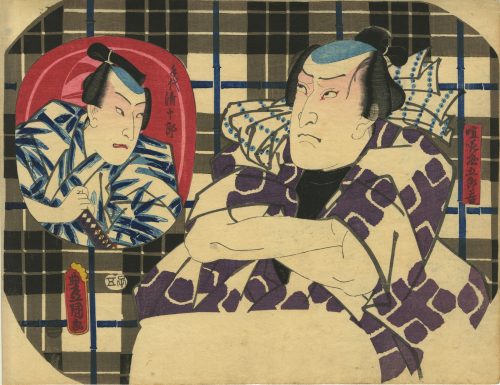 Artist: Utagawa Kunisada [歌川 国貞] a.k.a. Utagawa Toyokuni III [三代歌川豊国] (Japanese, 1786 – 1865). Publisher: Ibaya Senzaburō [伊場屋仙三郎] (Japanese, fl. C. 1845 – 1847). Date seal: [子五] Kaei 5, 5th month (5/1852). Signed: Toyokuni ga [豊国 画] in a red toshidama cartouche. Title: Actor Bandō Takesaburō I as clerk Seijūrō [手代清十郎] (left) and Actor Ichikawa Kodanji IV as Kenkaya Gorōkichi [喧嘩屋五郎吉] (right) in the play Musume ōgi tsui no tatehiki [娘扇一対侠贔屓 (むすめおうぎついのたてひき)] performed at the Nakamura theatre [中村座], in Edo (Tokyo). The playbill for this performance can be found at MFA (Boston) # 11.28042, 11.28285, 11.28286:
Artist: Utagawa Kunisada [歌川 国貞] a.k.a. Utagawa Toyokuni III [三代歌川豊国] (Japanese, 1786 – 1865). Publisher: Ibaya Senzaburō [伊場屋仙三郎] (Japanese, fl. C. 1845 – 1847). Date seal: [子五] Kaei 5, 5th month (5/1852). Signed: Toyokuni ga [豊国 画] in a red toshidama cartouche. Title: Actor Bandō Takesaburō I as clerk Seijūrō [手代清十郎] (left) and Actor Ichikawa Kodanji IV as Kenkaya Gorōkichi [喧嘩屋五郎吉] (right) in the play Musume ōgi tsui no tatehiki [娘扇一対侠贔屓 (むすめおうぎついのたてひき)] performed at the Nakamura theatre [中村座], in Edo (Tokyo). The playbill for this performance can be found at MFA (Boston) # 11.28042, 11.28285, 11.28286: Actors:
Bandō Takesaburō I (初代坂東竹三郎) (Japanese, 1832 – 1877); other names: Shinshi, Shinsui V, Bandō Hikosaburō V [五代目坂東彦三郎], Bandō Tsurunosuke I.
Ichikawa Kodanji IV [市川小團次] (Japanese, 1812 – 1866); other names: Ichikawa Yonejūrō I, Ichikawa Yonezō III, Ichikawa Eizō.
Actors:
Bandō Takesaburō I (初代坂東竹三郎) (Japanese, 1832 – 1877); other names: Shinshi, Shinsui V, Bandō Hikosaburō V [五代目坂東彦三郎], Bandō Tsurunosuke I.
Ichikawa Kodanji IV [市川小團次] (Japanese, 1812 – 1866); other names: Ichikawa Yonejūrō I, Ichikawa Yonezō III, Ichikawa Eizō.
Similar images were then used for the series Seven flourishing plants on lanterns for summer evenings [涼調珍盛の七草] (Suzumi chōchin sakari no nanakusa) published by Ibaya Senzaburō in 1852 (Kaei 5), 6th month.

Bandō Takesaburō I (carved by Yokokawa Takejirō): https://collections.mfa.org/objects/219360

Actor Ichikawa Kodanji IV (carved by Nakamura Tōkichi): https://collections.mfa.org/objects/477146.
-
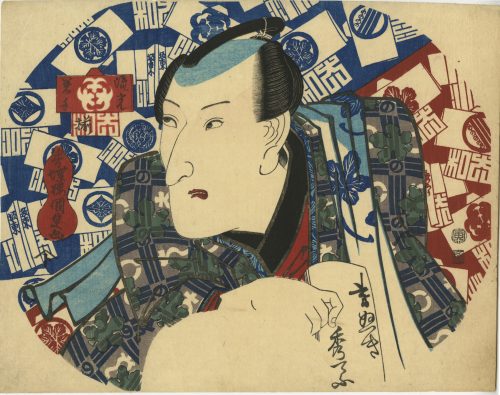 Artist: Utagawa Kunisada [歌川 国貞] a.k.a. Utagawa Toyokuni III [三代歌川豊国] (Japanese, 1786 – 1865). Signed: Kochoro Kuisada ga [香蝶楼国貞画] in a red double-gourd cartouche Publisher: Enshūya Matabei [遠州屋又兵衛] (Japanese, fl. c. 1768 – 1881). Series: Fashionable Youths [流行若手揃] (Ryuko Wakate Zoroi). Actor: Bandō Minosuke II [坂東蓑助] (Japanese, 1802 – 1863); other names: Morita Kan'ya XI, Bandô Mitsugorō IV. Date-kiwame seals: Bunsei 13 / Tenpō 1 (1830). One more print from the same series (See Waseda 201-2125); not in this collection: Segawa Kikunojō V [瀬川菊之丞] (Japanese, 1802 – 1832); other names: Segawa Tamon I.
Artist: Utagawa Kunisada [歌川 国貞] a.k.a. Utagawa Toyokuni III [三代歌川豊国] (Japanese, 1786 – 1865). Signed: Kochoro Kuisada ga [香蝶楼国貞画] in a red double-gourd cartouche Publisher: Enshūya Matabei [遠州屋又兵衛] (Japanese, fl. c. 1768 – 1881). Series: Fashionable Youths [流行若手揃] (Ryuko Wakate Zoroi). Actor: Bandō Minosuke II [坂東蓑助] (Japanese, 1802 – 1863); other names: Morita Kan'ya XI, Bandô Mitsugorō IV. Date-kiwame seals: Bunsei 13 / Tenpō 1 (1830). One more print from the same series (See Waseda 201-2125); not in this collection: Segawa Kikunojō V [瀬川菊之丞] (Japanese, 1802 – 1832); other names: Segawa Tamon I.
-
 Artist: Utagawa Kunisada [歌川 国貞] a.k.a. Utagawa Toyokuni III [三代歌川豊国] (Japanese, 1786 – 1865). Signed: Kōchō(rō) Kunisada ga (香蝶国貞画) in a red double-gourd cartouche. Publisher: Surugaya Sakujirō [駿河屋作次郎] (Japanese, fl. c. 1844 – 1865); Marks 06-005 | 501a. Single nanushi censor seal: Muramatsu (1843-6). The date is attributed to c. 1844. Title: Narihira [なり平]. Ariwara no Narihira [在原 業平] (Japanese, 825 – 880) – one of the Six Immortal Poets – The Rokkasen [六歌仙]. Series: A parody of six immortal poets [見立六花撰] (Mitate Rokkasen). Media: Untrimmed fan print (uchiwa-e), 227 x 293 mm, depicting a beautiful woman with a bow and arrows in her left hand. Series: Mitate Rokkasen [見立六花撰] – is sometimes interpreted as "A parody of six immortal poets" or "A comparison of six select flowers". [LIB-1212.2017] Robert Schaap. Kunisada: Imaging, drama and beauty. — Leiden: Hotei Publishing, 2016; pl. 28, p. 58. This is another fan print with another immortal poet, Bun'ya no Yasuhide [文屋 康秀] (Japanese, -d. 885?), from the same series, provided in the book:With special thanks to Horst Graebner for help with the description and date attribution: "The print can be dated to 1844: censor seal is Muramatsu (Muramatsu Genroku); he acted in 7/1844 and 4/1845 (and also later) as censor but Kunisada changed his name to Kunisada early in 1844."
Artist: Utagawa Kunisada [歌川 国貞] a.k.a. Utagawa Toyokuni III [三代歌川豊国] (Japanese, 1786 – 1865). Signed: Kōchō(rō) Kunisada ga (香蝶国貞画) in a red double-gourd cartouche. Publisher: Surugaya Sakujirō [駿河屋作次郎] (Japanese, fl. c. 1844 – 1865); Marks 06-005 | 501a. Single nanushi censor seal: Muramatsu (1843-6). The date is attributed to c. 1844. Title: Narihira [なり平]. Ariwara no Narihira [在原 業平] (Japanese, 825 – 880) – one of the Six Immortal Poets – The Rokkasen [六歌仙]. Series: A parody of six immortal poets [見立六花撰] (Mitate Rokkasen). Media: Untrimmed fan print (uchiwa-e), 227 x 293 mm, depicting a beautiful woman with a bow and arrows in her left hand. Series: Mitate Rokkasen [見立六花撰] – is sometimes interpreted as "A parody of six immortal poets" or "A comparison of six select flowers". [LIB-1212.2017] Robert Schaap. Kunisada: Imaging, drama and beauty. — Leiden: Hotei Publishing, 2016; pl. 28, p. 58. This is another fan print with another immortal poet, Bun'ya no Yasuhide [文屋 康秀] (Japanese, -d. 885?), from the same series, provided in the book:With special thanks to Horst Graebner for help with the description and date attribution: "The print can be dated to 1844: censor seal is Muramatsu (Muramatsu Genroku); he acted in 7/1844 and 4/1845 (and also later) as censor but Kunisada changed his name to Kunisada early in 1844."
Robert Schaap, 2016.
-
 Artist: Utagawa Kunisada [歌川 国貞] a.k.a. Utagawa Toyokuni III [三代歌川豊国] (Japanese, 1786 – 1865). Signed: Ōju Toyokuni ga [応需豊国画] in a toshidama cartouche. Double nanushi censor seals Mera & Murata (1846-50). Publisher: Kojimaya Jūbei [小嶋屋重兵衛] (Japanese, fl. c. 1797 – 1869). A gentleman, probably a kabuki actor Nakamura Utaemon IV [中村歌右衛門] (Nakamura Shikan II, Nakamura Tsurusuke I, Nakamura Tōtarō, Japanese, 1796 – 1852) drinking tea on a veranda under the shining moon. Series Moon, Sun, Stars [月日星] (tsuki-hi-hoshi/boshi), the three sources of light (sankō) [三光]:
Artist: Utagawa Kunisada [歌川 国貞] a.k.a. Utagawa Toyokuni III [三代歌川豊国] (Japanese, 1786 – 1865). Signed: Ōju Toyokuni ga [応需豊国画] in a toshidama cartouche. Double nanushi censor seals Mera & Murata (1846-50). Publisher: Kojimaya Jūbei [小嶋屋重兵衛] (Japanese, fl. c. 1797 – 1869). A gentleman, probably a kabuki actor Nakamura Utaemon IV [中村歌右衛門] (Nakamura Shikan II, Nakamura Tsurusuke I, Nakamura Tōtarō, Japanese, 1796 – 1852) drinking tea on a veranda under the shining moon. Series Moon, Sun, Stars [月日星] (tsuki-hi-hoshi/boshi), the three sources of light (sankō) [三光]: -
 Artist: Utagawa Kunisada [歌川 国貞] a.k.a. Utagawa Toyokuni III [三代歌川豊国] (Japanese, 1786 – 1865). Signed: Ōju Toyokuni ga [応需豊国画], in a toshidama cartouche. Double nanushi censor seals Mera & Murata (1846-50). Publisher: Kojimaya Jūbei [小嶋屋重兵衛] (Japanese, fl. c. 1797 – 1869). Kabuki actor Ichikawa Danjūrō VIII [市川団十郎] (Ichikawa Ebizō VI, Ichikawa Shinnosuke II, Japanese, 1823 – 1854) watches the sunrise over Mount Fuji. The complete set of series Moon, Sun, Stars [月日星] (tsuki-hi-hoshi/boshi), three sources of light (sankō) [三光]:
Artist: Utagawa Kunisada [歌川 国貞] a.k.a. Utagawa Toyokuni III [三代歌川豊国] (Japanese, 1786 – 1865). Signed: Ōju Toyokuni ga [応需豊国画], in a toshidama cartouche. Double nanushi censor seals Mera & Murata (1846-50). Publisher: Kojimaya Jūbei [小嶋屋重兵衛] (Japanese, fl. c. 1797 – 1869). Kabuki actor Ichikawa Danjūrō VIII [市川団十郎] (Ichikawa Ebizō VI, Ichikawa Shinnosuke II, Japanese, 1823 – 1854) watches the sunrise over Mount Fuji. The complete set of series Moon, Sun, Stars [月日星] (tsuki-hi-hoshi/boshi), three sources of light (sankō) [三光]: -
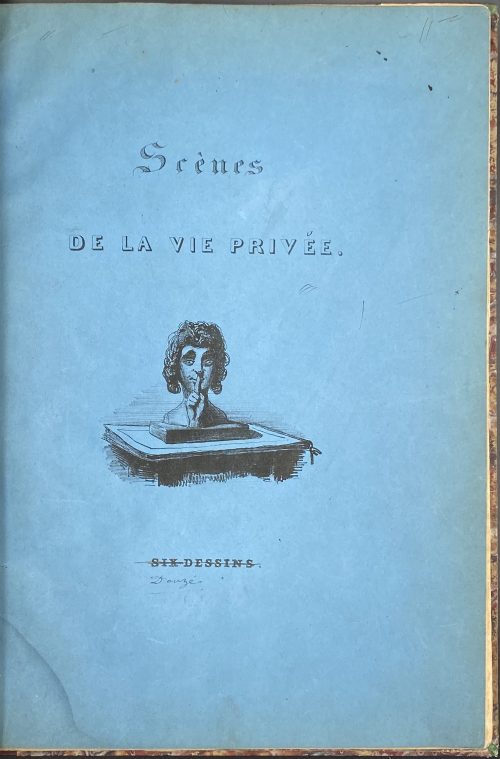 Pictorial album 31 x 22.8 cm, bound in quarter red calf over marbled boards with gilt lettering “SCÈNES | DE | LA VIE | PRIVÉE” and gilt ornament to spine; marbled endpapers, flyleaf, blue original wrapper (title-page) lettered SCÈNES | DE LA VIE PRIVÉE. | {vignette} | SIX DESSINS || «Six dessins» struck out, ms inscription beneath “Douze”. Twelve hand-coloured lithographs, some inscribed with letters and/or numbers in reverse, each in a double-rule frame 22 x 16.5 cm, images 18 x 14.5 cm (approx.); series title “Scènes de la vie intime” printed above the frame, image title printed in the lower compartment; ms numbers above the upper-right corner of the frame (state before sequential numbers, ms numbers do not correspond with artist numbering). Flyleaf at the end. Two bookplates to front pastedown: “EX-LIBRIS PAUL GAVAULT” and armorial “IN ROBORE ROBUR | Ex Libris Bourlon de Rouvre”. Content (Roman numerals in parenthesis are publisher's numbers; numerals in italic are Armelhault-Bocher reference numbers):
Pictorial album 31 x 22.8 cm, bound in quarter red calf over marbled boards with gilt lettering “SCÈNES | DE | LA VIE | PRIVÉE” and gilt ornament to spine; marbled endpapers, flyleaf, blue original wrapper (title-page) lettered SCÈNES | DE LA VIE PRIVÉE. | {vignette} | SIX DESSINS || «Six dessins» struck out, ms inscription beneath “Douze”. Twelve hand-coloured lithographs, some inscribed with letters and/or numbers in reverse, each in a double-rule frame 22 x 16.5 cm, images 18 x 14.5 cm (approx.); series title “Scènes de la vie intime” printed above the frame, image title printed in the lower compartment; ms numbers above the upper-right corner of the frame (state before sequential numbers, ms numbers do not correspond with artist numbering). Flyleaf at the end. Two bookplates to front pastedown: “EX-LIBRIS PAUL GAVAULT” and armorial “IN ROBORE ROBUR | Ex Libris Bourlon de Rouvre”. Content (Roman numerals in parenthesis are publisher's numbers; numerals in italic are Armelhault-Bocher reference numbers):- Titre de la couverture (Title-page) – 2001
- (III) Un nid dans les blés (A nest in the wheat) – 2004
- (II) Amitié de pension (Friendship in the pension) – 2003
- (XI) Bras dessus, bras dessous (Arm up, arm down) – 2012
- (I) Causerie (Chat) – 2002
- (VI) Prélude (Prelude) – 2007
- (IX) Le guet-apens (Ambush) – 2010
- (V) Le cabinet noir (The dark chamber) – 2006
- (IV) Distraction (Entertainment) – 2005
- (X) Leçon de paysage (Landscape lesson) – 2011
- (VII) Avant le péché (Before sin) – 2008
- (VIII) Après le péché (After sin) – 2009
- (XII) La femme du peintre (The painter's wife) – 2013
-
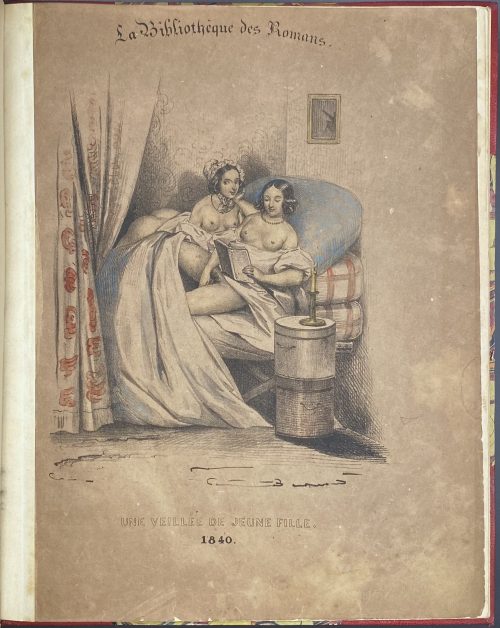 Description: Pictorial album 29.7 x 24 cm, bound in ¾ red morocco over marbled boards with gilt lettering “LA BIBLIOTHÈQUE DES ROMANS” and raised bands to spine; marbled endpapers, two flyleaves, tan original wrapper lettered “La Bibliothèque des Romans. (gothic, arch) | {colour vignette} | UNE VEILLÉE DE JEUNE FILLE. | 1840. || Six hand-coloured lithographs, each in a double-rule border with the series title above it and image title below. Sequential numbers are hand-inscribed within the border in the upper-right corner. Frame 23.5 x 18.3 cm, image 21.5 x 16.5 cm. Three flyleaves at the end. A bookplate to front pastedown: “GERARD NORDMANN EX-LIBRIS”. Content:
Description: Pictorial album 29.7 x 24 cm, bound in ¾ red morocco over marbled boards with gilt lettering “LA BIBLIOTHÈQUE DES ROMANS” and raised bands to spine; marbled endpapers, two flyleaves, tan original wrapper lettered “La Bibliothèque des Romans. (gothic, arch) | {colour vignette} | UNE VEILLÉE DE JEUNE FILLE. | 1840. || Six hand-coloured lithographs, each in a double-rule border with the series title above it and image title below. Sequential numbers are hand-inscribed within the border in the upper-right corner. Frame 23.5 x 18.3 cm, image 21.5 x 16.5 cm. Three flyleaves at the end. A bookplate to front pastedown: “GERARD NORDMANN EX-LIBRIS”. Content:- Front wrapper (title-page)
- SŒUR ANNE (Sister Anne)
- LA GRISETTE (The grisette)
- LÉONIDE OU LA VIEILLE DE SURÊNE (Léonide or the old lady of Surêne)
- LA PUCELLE DE BELLEVILLE (The maid of Belleville)
- MON VOISIN RAYMOND (My neighbor Raymond)
- LE COCU (The cuckold)
-
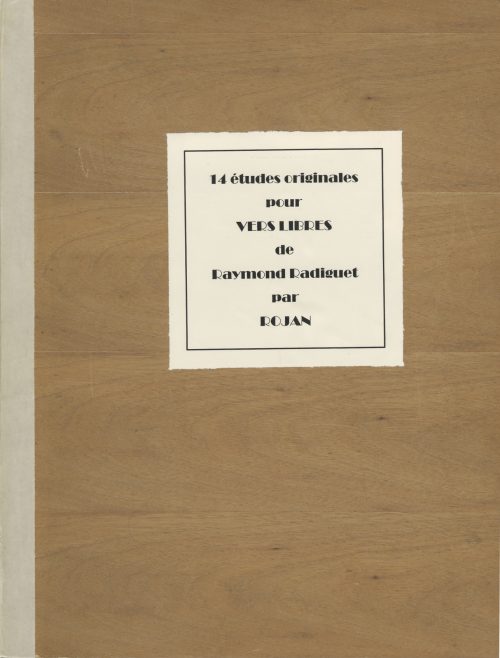 Portfolio of 14 original watercolour illustrations for Vers Libres by Raymond Radiguet. Painted on wove paper of different sizes, each mounted in a passe-partout 39,5 x 33 cm and enclosed in a flapped portfolio with a white label to front cover lettered "14 études originales | pour | VERS LIBRES | de | Raymond Radiguet | par | ROJAN". For published versions see:
Portfolio of 14 original watercolour illustrations for Vers Libres by Raymond Radiguet. Painted on wove paper of different sizes, each mounted in a passe-partout 39,5 x 33 cm and enclosed in a flapped portfolio with a white label to front cover lettered "14 études originales | pour | VERS LIBRES | de | Raymond Radiguet | par | ROJAN". For published versions see:- [LIB-2830.2021] Raymond Radiguet. Vers libres / [Illustrés par Rojan]. — Champigny: Au Panier Fleuri [i.e. Paris, René Bonnel, c. 1935].
- [LIB-2827.2021] Raymond Radiguet. Vers libres / Illustrés par Rojan. — Nogent: Au Panier Fleuri [i.e. Paris, c. 1937].
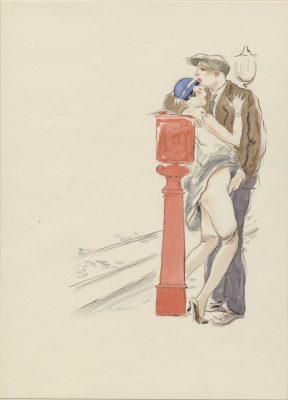
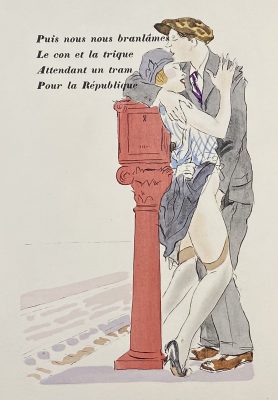



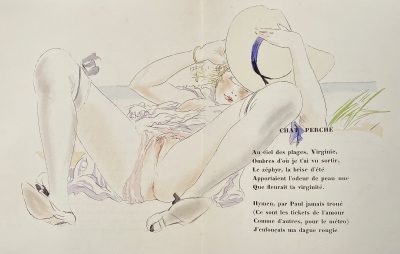
-
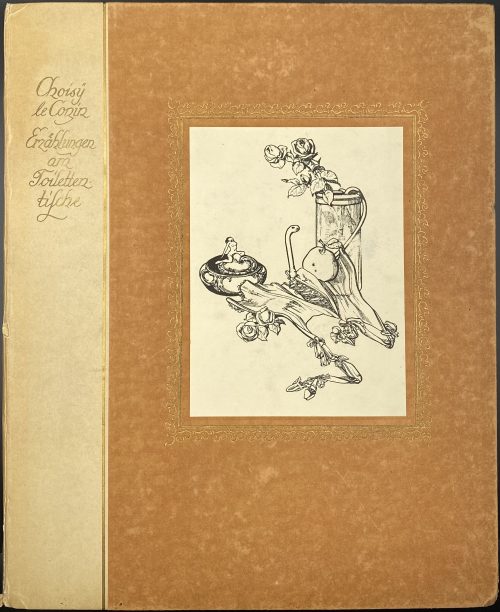 Publisher's flapped portfolio 32.8 x 26.8 cm, gilt-ruled and gilt-lettered quarter faux-parchment waxed paper over brown paper boards with pasted illustration after von Bayros within gilt arabesque frame. Possibly published in Vienna by Heinrich Conrad in 1905 or 1908. The portfolio contains the title page with a vignette and 15 loose wove paper sheets 32 x 26.2 cm of collotype reproductions after drawings by Franz von Bayros. Cover gilt lettering: Choisÿ | le Conin | Erzählungen | am | Toiletten- | tische || Title-page: Erzählungen | am Toilettentische | von | CHOISY LE CONIN | {vignette} || Title-page verso: Inhalt: | 1. Die Tabaksdose | 2. Viola de Gamba | 3. Der Bote | 4. Nicht drängeln, Kinder! | 5. Die blaue Feder | 6. O what a pretty like-place! | 7. Die Sonnenuhr |8. Der Temel der der Cotÿs | 9. Der Fetischist | 10. Jupiter und Europa | 11. Die Witwe | 12. Paroxÿsme-erotique | 13. Der Rivale | 14. Die rote Lehrerin | 15. Tantalus | Nicht im Handel. || Catalogue raisonné: The amorous drawings of the Marquis von Bayros / Part I and II. — NY: Cythera Press, 1968; pp. 95-111 [LIB-2246.2019]
Publisher's flapped portfolio 32.8 x 26.8 cm, gilt-ruled and gilt-lettered quarter faux-parchment waxed paper over brown paper boards with pasted illustration after von Bayros within gilt arabesque frame. Possibly published in Vienna by Heinrich Conrad in 1905 or 1908. The portfolio contains the title page with a vignette and 15 loose wove paper sheets 32 x 26.2 cm of collotype reproductions after drawings by Franz von Bayros. Cover gilt lettering: Choisÿ | le Conin | Erzählungen | am | Toiletten- | tische || Title-page: Erzählungen | am Toilettentische | von | CHOISY LE CONIN | {vignette} || Title-page verso: Inhalt: | 1. Die Tabaksdose | 2. Viola de Gamba | 3. Der Bote | 4. Nicht drängeln, Kinder! | 5. Die blaue Feder | 6. O what a pretty like-place! | 7. Die Sonnenuhr |8. Der Temel der der Cotÿs | 9. Der Fetischist | 10. Jupiter und Europa | 11. Die Witwe | 12. Paroxÿsme-erotique | 13. Der Rivale | 14. Die rote Lehrerin | 15. Tantalus | Nicht im Handel. || Catalogue raisonné: The amorous drawings of the Marquis von Bayros / Part I and II. — NY: Cythera Press, 1968; pp. 95-111 [LIB-2246.2019] -
 Utagawa Kunisada [歌川 国貞] a.k.a. Utagawa Toyokuni III [三代歌川豊国] (Japanese, 1786 – 1865). Signed: Toyokuni ga [豊国 画] in a yellow toshidama cartouche. Publisher: Unknown, seal [久] Kyū (Japanese, fl. c. 1851 – 1861); (Marks 07-023 | U176a, possibly Sagamia Kyūzō). Block carver: Koizumi Minokichi [小泉巳の吉] (Japanese, 1833 – 1906); seal: Hori Mino [彫已の] (Gordon Friese № 38). Date seal and double nanushi censor seals: Fuku & Muramatsu, Kaei 6, 2nd month (2/1853). Inscription in a red cartouche: (Purple of Edo // Purple of the Bay Capital) [江都むらさき] (Edo Murasaki), alluding to Murasaki Shikibu [紫 式部] (Japanese, c. 973/8 – c. 1014/31), the author of Genji Monogatari [源氏物語] (The Tale of Genji), a Heian period novel which was the source of a parody Nise Murasaki Inaka Genji [偐紫田舎源氏] (Fake Murasaki’s Rustic Genji) by Ryutei Tanehiko [柳亭種彦] (Japanese, 1783 – 1842). According to Horst Graebner: The actor is most probably Segawa Kikunojō V. Segawa Kikunojō V [瀬川菊之丞] (Japanese, 1802 – 1832); other names: Segawa Tamon I. One of the series of Kunisada's fan prints in this collection:
Utagawa Kunisada [歌川 国貞] a.k.a. Utagawa Toyokuni III [三代歌川豊国] (Japanese, 1786 – 1865). Signed: Toyokuni ga [豊国 画] in a yellow toshidama cartouche. Publisher: Unknown, seal [久] Kyū (Japanese, fl. c. 1851 – 1861); (Marks 07-023 | U176a, possibly Sagamia Kyūzō). Block carver: Koizumi Minokichi [小泉巳の吉] (Japanese, 1833 – 1906); seal: Hori Mino [彫已の] (Gordon Friese № 38). Date seal and double nanushi censor seals: Fuku & Muramatsu, Kaei 6, 2nd month (2/1853). Inscription in a red cartouche: (Purple of Edo // Purple of the Bay Capital) [江都むらさき] (Edo Murasaki), alluding to Murasaki Shikibu [紫 式部] (Japanese, c. 973/8 – c. 1014/31), the author of Genji Monogatari [源氏物語] (The Tale of Genji), a Heian period novel which was the source of a parody Nise Murasaki Inaka Genji [偐紫田舎源氏] (Fake Murasaki’s Rustic Genji) by Ryutei Tanehiko [柳亭種彦] (Japanese, 1783 – 1842). According to Horst Graebner: The actor is most probably Segawa Kikunojō V. Segawa Kikunojō V [瀬川菊之丞] (Japanese, 1802 – 1832); other names: Segawa Tamon I. One of the series of Kunisada's fan prints in this collection: -
 Utagawa Kunisada [歌川 国貞]; a.k.a. Utagawa Toyokuni III [三代歌川豊国] (Japanese, 1786 – 1865). Signed: Toyokuni ga [豊国 画] in a yellow toshidama cartouche. Publisher: Unknown, seal [久] Kyū (Japanese, fl. c. 1851 – 1861); (Marks 07-023 | U176a, possibly Sagamia Kyūzō). Date seal and double nanushi censor seals: Fuku & Muramatsu, Kaei 6, 2nd month (2/1853). Inscription in a red cartouche: (Purple of Edo // Purple of the Bay Capital) [江都むらさき] (Edo Murasaki), alluding to Murasaki Shikibu [紫 式部] (Japanese, c. 973/8 – c. 1014/31), the author of Genji Monogatari [源氏物語] (The Tale of Genji), a Heian period novel which was the source of a parody Nise Murasaki Inaka Genji [偐紫田舎源氏] (Fake Murasaki’s Rustic Genji) by Ryutei Tanehiko [柳亭種彦] (Japanese, 1783 – 1842). According to Horst Graebner: The actor is Ichikawa Danjūrō VIII. Ichikawa Danjūrō VIII [市川団十郎] (Japanese, 1823 – 1854); other names: Ichikawa Ebizō VI, Ichikawa Shinnosuke II. One of the series of Kunisada’s fan prints in this collection:
Utagawa Kunisada [歌川 国貞]; a.k.a. Utagawa Toyokuni III [三代歌川豊国] (Japanese, 1786 – 1865). Signed: Toyokuni ga [豊国 画] in a yellow toshidama cartouche. Publisher: Unknown, seal [久] Kyū (Japanese, fl. c. 1851 – 1861); (Marks 07-023 | U176a, possibly Sagamia Kyūzō). Date seal and double nanushi censor seals: Fuku & Muramatsu, Kaei 6, 2nd month (2/1853). Inscription in a red cartouche: (Purple of Edo // Purple of the Bay Capital) [江都むらさき] (Edo Murasaki), alluding to Murasaki Shikibu [紫 式部] (Japanese, c. 973/8 – c. 1014/31), the author of Genji Monogatari [源氏物語] (The Tale of Genji), a Heian period novel which was the source of a parody Nise Murasaki Inaka Genji [偐紫田舎源氏] (Fake Murasaki’s Rustic Genji) by Ryutei Tanehiko [柳亭種彦] (Japanese, 1783 – 1842). According to Horst Graebner: The actor is Ichikawa Danjūrō VIII. Ichikawa Danjūrō VIII [市川団十郎] (Japanese, 1823 – 1854); other names: Ichikawa Ebizō VI, Ichikawa Shinnosuke II. One of the series of Kunisada’s fan prints in this collection: -
 Artist: Utagawa Kunisada [歌川 国貞] a.k.a. Utagawa Toyokuni III [三代歌川豊国] (Japanese, 1786 – 1865). Signed: Toyokuni ga [豊国 画] in a red toshidama cartouche. Publisher: Ibaya Senzaburō [伊場屋仙三郎] (Japanese, c. 1815 – 1869). Block carver: Yokokawa Takejirō [横川竹二郎] (Japanese, fl. 1845 – 1863); seal Hori Take [彫竹]. Double nanushi censor seals: Mera & Murata (1847-50). Title: Cool Breeze on Tenpōzan Hill in Naniwa [浪花天保山の涼] (Naniwa Tenpōzan no ryō). An uncut fan print (uchiwa-e), depicting a gentleman (most probably kabuki actor Nakamura Utaemon IV) holding a pipe with the view of Tenpōzan Hill [天保山] in Naniwa (Osaka) in the background. A distinctive structure on the left is the Sumiyoshi Lantern [住吉高灯篭] (Sumiyoshi takadōrō), which was destroyed by a typhoon in 1950. The character 翫 – moteasobu – on the gentleman’s robe means "take pleasure, play an instrument". Nakamura Utaemon IV [中村歌右衛門] (Japanese, 1796 – 1852); other names: Nakamura Shikan II, Nakamura Tsurusuke I, Nakamura Tōtarō. The character is visually similar to a gentleman drinking tea on a veranda under the shining moon from the series ‘Moon, Sun, Stars’ [月日星] (Getsu hi hoshi), see SVJP-0211-1.2016: The Moon.
Artist: Utagawa Kunisada [歌川 国貞] a.k.a. Utagawa Toyokuni III [三代歌川豊国] (Japanese, 1786 – 1865). Signed: Toyokuni ga [豊国 画] in a red toshidama cartouche. Publisher: Ibaya Senzaburō [伊場屋仙三郎] (Japanese, c. 1815 – 1869). Block carver: Yokokawa Takejirō [横川竹二郎] (Japanese, fl. 1845 – 1863); seal Hori Take [彫竹]. Double nanushi censor seals: Mera & Murata (1847-50). Title: Cool Breeze on Tenpōzan Hill in Naniwa [浪花天保山の涼] (Naniwa Tenpōzan no ryō). An uncut fan print (uchiwa-e), depicting a gentleman (most probably kabuki actor Nakamura Utaemon IV) holding a pipe with the view of Tenpōzan Hill [天保山] in Naniwa (Osaka) in the background. A distinctive structure on the left is the Sumiyoshi Lantern [住吉高灯篭] (Sumiyoshi takadōrō), which was destroyed by a typhoon in 1950. The character 翫 – moteasobu – on the gentleman’s robe means "take pleasure, play an instrument". Nakamura Utaemon IV [中村歌右衛門] (Japanese, 1796 – 1852); other names: Nakamura Shikan II, Nakamura Tsurusuke I, Nakamura Tōtarō. The character is visually similar to a gentleman drinking tea on a veranda under the shining moon from the series ‘Moon, Sun, Stars’ [月日星] (Getsu hi hoshi), see SVJP-0211-1.2016: The Moon. As noted by Horst Graebner, the gentleman also resembles the character on another Kunisada's actor print, published in 1852 (Waseda University Cultural Resources Database № 114-0232):
As noted by Horst Graebner, the gentleman also resembles the character on another Kunisada's actor print, published in 1852 (Waseda University Cultural Resources Database № 114-0232):

-
 Artist: Horst Graebner positively attributes the drawing to Utagawa Kunisada II [歌川国貞] Japanese, 1823 – 1880) a.k.a. Toyokuni IV, though Israel Goldman attributes it to Utagawa Kunisada [歌川 国貞] (Japanese, 1786 – 1865) a.k.a. Utagawa Toyokuni III. Title: Geisha with a watch / Preparatory drawing for a fan print. Media/Technique: Ink and colour on paper. Signed: Toyokuni hitsu [豊国筆].
Artist: Horst Graebner positively attributes the drawing to Utagawa Kunisada II [歌川国貞] Japanese, 1823 – 1880) a.k.a. Toyokuni IV, though Israel Goldman attributes it to Utagawa Kunisada [歌川 国貞] (Japanese, 1786 – 1865) a.k.a. Utagawa Toyokuni III. Title: Geisha with a watch / Preparatory drawing for a fan print. Media/Technique: Ink and colour on paper. Signed: Toyokuni hitsu [豊国筆]. -
 Artist: Utagawa Kunisada [歌川 国貞] a.k.a. Utagawa Toyokuni III [三代歌川豊国] (Japanese, 1786 – 1865). Signed: Ichiyōsai Toyokuni hitsu [一陽斎豊国筆]. Inscriptions: [松竹梅] Shochikubai = pine (matsu, 松), bamboo (take, 竹), and plum (ume, 梅) – an auspicious grouping known as “The Three Friends of Winter“; [三福追] (Sanpuku tsui) – the three delights, or pleasures. Date seal and aratame censor seal: Ansei 2, 1st month (1855). Publisher: Ibaya Senzaburō [伊場屋仙三郎] (Japanese, c. 1815 – 1869). Block carver: Yokokawa Takejirō [横川竹二郎] (Japanese, fl. 1845 – 1863); seal: Hori Take [彫竹]. Kabuki actor Onoe Kikugorō V [五代目尾上菊五郎] (Onoe Baikō V, Ichimura Kakitsu IV, Ichimura Uzaemon XIII, Ichimura Kurōemon, Japanese, 1844 – 1903) giving candies to the memorial portrait of his predecessor, Ichimura Takenojō V [市村竹之丞] (Ichimura Uzaemon XII, Ichimura Kamenosuke, Ichimura Toyomatsu, Japanese, 1812 – 1851); the latter is dressed in a green robe adorned with a crest (mon) of a kōrin-style crane in a tortoiseshell (octagon), the hanging scroll border decorated with bamboo under snow; the collar of Onoe's kimono decorated with plum blossoms, another plum blossom arrangement decorates the screen behind him. Actors identified by Horst Graebner. Two fan prints from this series in Varshavsky Collection:
Artist: Utagawa Kunisada [歌川 国貞] a.k.a. Utagawa Toyokuni III [三代歌川豊国] (Japanese, 1786 – 1865). Signed: Ichiyōsai Toyokuni hitsu [一陽斎豊国筆]. Inscriptions: [松竹梅] Shochikubai = pine (matsu, 松), bamboo (take, 竹), and plum (ume, 梅) – an auspicious grouping known as “The Three Friends of Winter“; [三福追] (Sanpuku tsui) – the three delights, or pleasures. Date seal and aratame censor seal: Ansei 2, 1st month (1855). Publisher: Ibaya Senzaburō [伊場屋仙三郎] (Japanese, c. 1815 – 1869). Block carver: Yokokawa Takejirō [横川竹二郎] (Japanese, fl. 1845 – 1863); seal: Hori Take [彫竹]. Kabuki actor Onoe Kikugorō V [五代目尾上菊五郎] (Onoe Baikō V, Ichimura Kakitsu IV, Ichimura Uzaemon XIII, Ichimura Kurōemon, Japanese, 1844 – 1903) giving candies to the memorial portrait of his predecessor, Ichimura Takenojō V [市村竹之丞] (Ichimura Uzaemon XII, Ichimura Kamenosuke, Ichimura Toyomatsu, Japanese, 1812 – 1851); the latter is dressed in a green robe adorned with a crest (mon) of a kōrin-style crane in a tortoiseshell (octagon), the hanging scroll border decorated with bamboo under snow; the collar of Onoe's kimono decorated with plum blossoms, another plum blossom arrangement decorates the screen behind him. Actors identified by Horst Graebner. Two fan prints from this series in Varshavsky Collection:
SVJP-0335.2021
-
 Artist: Utagawa Kunisada [歌川 国貞] a.k.a. Utagawa Toyokuni III [三代歌川豊国] (Japanese, 1786 – 1865). Signed: Ichiyōsai Toyokuni hitsu [一陽斎豊国筆]. Inscriptions: [松竹梅] Shochikubai = pine (matsu, 松), bamboo (take, 竹), and plum (ume, 梅) – an auspicious grouping known as "The Three Friends of Winter"; [三福追] (Sanpuku tsui) – the three delights, or pleasures. Date seal and aratame censor seal: Ansei 2, 1st month (1855). Publisher: Ibaya Senzaburō [伊場屋仙三郎] (Japanese, c. 1815 – 1869). Block carver: Yokokawa Takejirō [横川竹二郎] (Japanese, fl. 1845 – 1863); seal: Hori Take [彫竹]. Kabuki actor Nakamura Shikan IV [中村芝翫] (Nakamura Fukusuke I [中村福助], Nakamura Masanosuke I, Nakamura Komasaburō, Nakamura Tamatarō I, Japanese, 1831 – 1899) arranging a branch of blossoming plum to the memorial portrait of his predecessor Nakamura Utaemon IV [中村歌右衛門] (Nakamura Shikan II, Nakamura Tsurusuke I, Nakamura Tōtarō, Japanese, 1796 – 1852); the latter is dressed in a black robe adorned with a mokkō-crest (mon) of white plum blossom, the hanging scroll border decorated with arabesque and plum blossoms. Actors identified by Horst Graebner. Two fan prints from this series in Varshavsky Collection:
Artist: Utagawa Kunisada [歌川 国貞] a.k.a. Utagawa Toyokuni III [三代歌川豊国] (Japanese, 1786 – 1865). Signed: Ichiyōsai Toyokuni hitsu [一陽斎豊国筆]. Inscriptions: [松竹梅] Shochikubai = pine (matsu, 松), bamboo (take, 竹), and plum (ume, 梅) – an auspicious grouping known as "The Three Friends of Winter"; [三福追] (Sanpuku tsui) – the three delights, or pleasures. Date seal and aratame censor seal: Ansei 2, 1st month (1855). Publisher: Ibaya Senzaburō [伊場屋仙三郎] (Japanese, c. 1815 – 1869). Block carver: Yokokawa Takejirō [横川竹二郎] (Japanese, fl. 1845 – 1863); seal: Hori Take [彫竹]. Kabuki actor Nakamura Shikan IV [中村芝翫] (Nakamura Fukusuke I [中村福助], Nakamura Masanosuke I, Nakamura Komasaburō, Nakamura Tamatarō I, Japanese, 1831 – 1899) arranging a branch of blossoming plum to the memorial portrait of his predecessor Nakamura Utaemon IV [中村歌右衛門] (Nakamura Shikan II, Nakamura Tsurusuke I, Nakamura Tōtarō, Japanese, 1796 – 1852); the latter is dressed in a black robe adorned with a mokkō-crest (mon) of white plum blossom, the hanging scroll border decorated with arabesque and plum blossoms. Actors identified by Horst Graebner. Two fan prints from this series in Varshavsky Collection:
SVJP-0336.2021
-
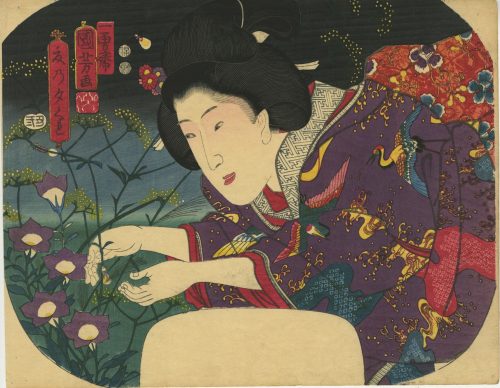 Artist: Utagawa Kuniyoshi [歌川 國芳] (Japanese, 1798 – 1861). Publisher: Enshuya Matabei [遠州屋又兵衛] (Japanese, fl. c. 178 – 1881) – no seal, ref: Kunisada Project. Title: A Summer Evening [夏乃夕暮] (Natsu no Yūgure). A young woman in purple kimono decorated with cranes and waves catching a firefly among yellow and purple flowers. Signed: Ichiyosai Kuniyoshi ga [一勇斎 国芳 画] in a red cartouche and sealed with paulownia (kiri mon). Date seal and double nanushi censor seals: Fuku & Muramatsu, 1853 (Kaei 6, 2nd month). No publisher's seal. Size: Uchiwa-e (untrimmed fan print) 228 x 296 mm. The yellow flower is probably Patrinia scabiosifolia (ominaeshi) [女郎花]. The purple flower seems to be Platycodon grandiflorus or Balloon Flower (kikyō) [桔梗]. Besides, there are visible panicles of Miscanthus sinensis, or Japanese pampas grass (susuki) [薄]. These three are part of the Seven Grasses of Autumn (aki no nanakusa) [秋の七草].
Artist: Utagawa Kuniyoshi [歌川 國芳] (Japanese, 1798 – 1861). Publisher: Enshuya Matabei [遠州屋又兵衛] (Japanese, fl. c. 178 – 1881) – no seal, ref: Kunisada Project. Title: A Summer Evening [夏乃夕暮] (Natsu no Yūgure). A young woman in purple kimono decorated with cranes and waves catching a firefly among yellow and purple flowers. Signed: Ichiyosai Kuniyoshi ga [一勇斎 国芳 画] in a red cartouche and sealed with paulownia (kiri mon). Date seal and double nanushi censor seals: Fuku & Muramatsu, 1853 (Kaei 6, 2nd month). No publisher's seal. Size: Uchiwa-e (untrimmed fan print) 228 x 296 mm. The yellow flower is probably Patrinia scabiosifolia (ominaeshi) [女郎花]. The purple flower seems to be Platycodon grandiflorus or Balloon Flower (kikyō) [桔梗]. Besides, there are visible panicles of Miscanthus sinensis, or Japanese pampas grass (susuki) [薄]. These three are part of the Seven Grasses of Autumn (aki no nanakusa) [秋の七草]. -
 Artist: Utagawa Kuniyoshi [歌川 國芳] (Japanese, 1798 – 1861). Publisher: Izuzen (fl. c. 1800s – 1840s) (Marks 06-029|U103b). Signed: Ichiyosai Kuniyoshi ga in a red cartouche and sealed with paulownia crest (kiri mon). Double nanushi censor seals: Fuku & Muramatsu, 1849-51 (Kaei 2 – Kaei 4). Young woman in front of the western-style framed portrait of Soga Tokimune, who is depicted after having his kusazuri ripped off by Asahina Saburō. The series of fan prints A Collection of Pictures in Modern Style [今様額面合] (Imayô gakumen awase) can be found at Kuniyoshi Project. Soga Tokimune, a.k.a. Soga no Gorō [曾我時致] (Japanese, 1174 – 1193), a historical figure and a character of an epic tale Soga Monogatari [曽我物語] (A Tale of Soga Brothers). Asahina Saburō [朝比奈 三朗], a.k.a. Asahina Yoshihide [朝比奈 義秀] is also mentioned in the Soga Monogatari. Kusazuri [草摺] (くさずり) – tassets on a suit of a samurai's armour. Another Kuniyoshi's print with the same characters: Goro Tokimune and Asahina Saburo; Series: The Tale of Soga Brothers; Publisher: Ibaya Senzaburō; Date: 1843-1845; Size: Vertical Ōban: 359 x 245 mm.
Artist: Utagawa Kuniyoshi [歌川 國芳] (Japanese, 1798 – 1861). Publisher: Izuzen (fl. c. 1800s – 1840s) (Marks 06-029|U103b). Signed: Ichiyosai Kuniyoshi ga in a red cartouche and sealed with paulownia crest (kiri mon). Double nanushi censor seals: Fuku & Muramatsu, 1849-51 (Kaei 2 – Kaei 4). Young woman in front of the western-style framed portrait of Soga Tokimune, who is depicted after having his kusazuri ripped off by Asahina Saburō. The series of fan prints A Collection of Pictures in Modern Style [今様額面合] (Imayô gakumen awase) can be found at Kuniyoshi Project. Soga Tokimune, a.k.a. Soga no Gorō [曾我時致] (Japanese, 1174 – 1193), a historical figure and a character of an epic tale Soga Monogatari [曽我物語] (A Tale of Soga Brothers). Asahina Saburō [朝比奈 三朗], a.k.a. Asahina Yoshihide [朝比奈 義秀] is also mentioned in the Soga Monogatari. Kusazuri [草摺] (くさずり) – tassets on a suit of a samurai's armour. Another Kuniyoshi's print with the same characters: Goro Tokimune and Asahina Saburo; Series: The Tale of Soga Brothers; Publisher: Ibaya Senzaburō; Date: 1843-1845; Size: Vertical Ōban: 359 x 245 mm.
-
 Artist: Utagawa Kuniyoshi [歌川 國芳] (Japanese, 1798 – 1861). Publisher: Ibaya Senzaburō [伊場屋仙三郎] (Japanese, c. 1815 – 1869). Published in c. 1845 (no seal). Possibly, from the "Untitled series of beauties reflected in mirrors", see Kunisada Project. However, this print does not have the seal of the censor Tanaka [田中].
Artist: Utagawa Kuniyoshi [歌川 國芳] (Japanese, 1798 – 1861). Publisher: Ibaya Senzaburō [伊場屋仙三郎] (Japanese, c. 1815 – 1869). Published in c. 1845 (no seal). Possibly, from the "Untitled series of beauties reflected in mirrors", see Kunisada Project. However, this print does not have the seal of the censor Tanaka [田中]. -
 Artist: Utagawa Kuniyoshi [歌川 國芳] (Japanese, 1798 – 1861). Publisher: Ibaya Senzaburō [伊場屋仙三郎] (Japanese, c. 1815 – 1869). Date-aratame seal: 1827 (Bunsei 10). Inscription: Ohan [おはん], Chōemon [長右衛門] | Dainingyō [大人形] | Yoshida Senshi [吉田千四)] | unclear (work in progress). Sam. L. Leiter describes the play in his Kabuki Encyclopedia (1979) p. 183, and Japanese traditional theatre (2014), p. 252 as "Love Suicide of Ohan and Choemon at the Katsura River" (Katsuragawa Renri no Shigarami) [桂川連理柵], a two-act play by Suga Sensuke [菅専助] (ca. 1728 – 1791) written in 1776 for the puppet theatre jūruri and adopted for Osaka kabuki in 1777. Yoshida Senshi, a.k.a. Yoshida Bunzaburo III was a Japanese puppeteer of a Yoshida lineage. The line was established by Yoshida Bunzaburō I [吉田文三郎] (Japanese, fl. 1717 – 1760), who was one of the greatest in the history of Bunraku [人形浄瑠璃] (ningyō jōruri) and who around 1734 introduced the three-man puppet manipulation system. A portrait of Yoshida Senshi, who died in 1829, can be found in the Kunisada's triptych at Jordan Schnitzer Museum of Art, ID Number 2016:37.2.).
Artist: Utagawa Kuniyoshi [歌川 國芳] (Japanese, 1798 – 1861). Publisher: Ibaya Senzaburō [伊場屋仙三郎] (Japanese, c. 1815 – 1869). Date-aratame seal: 1827 (Bunsei 10). Inscription: Ohan [おはん], Chōemon [長右衛門] | Dainingyō [大人形] | Yoshida Senshi [吉田千四)] | unclear (work in progress). Sam. L. Leiter describes the play in his Kabuki Encyclopedia (1979) p. 183, and Japanese traditional theatre (2014), p. 252 as "Love Suicide of Ohan and Choemon at the Katsura River" (Katsuragawa Renri no Shigarami) [桂川連理柵], a two-act play by Suga Sensuke [菅専助] (ca. 1728 – 1791) written in 1776 for the puppet theatre jūruri and adopted for Osaka kabuki in 1777. Yoshida Senshi, a.k.a. Yoshida Bunzaburo III was a Japanese puppeteer of a Yoshida lineage. The line was established by Yoshida Bunzaburō I [吉田文三郎] (Japanese, fl. 1717 – 1760), who was one of the greatest in the history of Bunraku [人形浄瑠璃] (ningyō jōruri) and who around 1734 introduced the three-man puppet manipulation system. A portrait of Yoshida Senshi, who died in 1829, can be found in the Kunisada's triptych at Jordan Schnitzer Museum of Art, ID Number 2016:37.2.). The design on our fan print looks very much like the one of Toyokuni I at MFA (Houston): OBJECT NUMBER 2006.378. "Seki Sanjuro as Obiya Choemon and Ichikawa Denzo as Ohan of the Shinonoya from the Kabuki Drama Katsuragawa renri no shigarami (Love Suicide of Ohan and Choemon at the Katsura River)", according to MFA-H published by someone Tsuruya in c. 1810 (though the publisher's seal is Suzuki Ihei [鈴木伊兵衛] (seal name Suzui [鈴伊]), Marks 01-028 | 502; the censor's seal is gyōji, date 1811-14).
The design on our fan print looks very much like the one of Toyokuni I at MFA (Houston): OBJECT NUMBER 2006.378. "Seki Sanjuro as Obiya Choemon and Ichikawa Denzo as Ohan of the Shinonoya from the Kabuki Drama Katsuragawa renri no shigarami (Love Suicide of Ohan and Choemon at the Katsura River)", according to MFA-H published by someone Tsuruya in c. 1810 (though the publisher's seal is Suzuki Ihei [鈴木伊兵衛] (seal name Suzui [鈴伊]), Marks 01-028 | 502; the censor's seal is gyōji, date 1811-14).
 Interestingly enough, the description provided by Kuniyoshi Project is this "Actors: Onoe Kikugorô III as Shinanoya Ohan (おはん, female) and Ichikawa Ebizô V as Obiya Choemon (長右衛門, male). Play: Go chumon shusu no Obiya (御注文繻子帯屋). Date: 3rd month of 1840. Theater: Kawarasaki. Publisher: Iba-ya Sensaburô".
The play Go chumon shusu no Obiya was indeed staged at Kawarazaki theatre in 1840 (Tenpō 11), 3rd month; Ichikawa Ebizō V was indeed playing Obiya Choemon but Onoe Kikugorō III had the role of Kataoka Kōzaemon, not of Ohan, as can be seen on Kunisada's diptych at MFA (Boston): ACCESSION NUMBER 11.40671a-b.
Interestingly enough, the description provided by Kuniyoshi Project is this "Actors: Onoe Kikugorô III as Shinanoya Ohan (おはん, female) and Ichikawa Ebizô V as Obiya Choemon (長右衛門, male). Play: Go chumon shusu no Obiya (御注文繻子帯屋). Date: 3rd month of 1840. Theater: Kawarasaki. Publisher: Iba-ya Sensaburô".
The play Go chumon shusu no Obiya was indeed staged at Kawarazaki theatre in 1840 (Tenpō 11), 3rd month; Ichikawa Ebizō V was indeed playing Obiya Choemon but Onoe Kikugorō III had the role of Kataoka Kōzaemon, not of Ohan, as can be seen on Kunisada's diptych at MFA (Boston): ACCESSION NUMBER 11.40671a-b.

Actors Ichikawa Ebizô V as Obiya Chôemon (R) and Onoe Kikugorô III as Kataoka Kôzaemon (L)
-
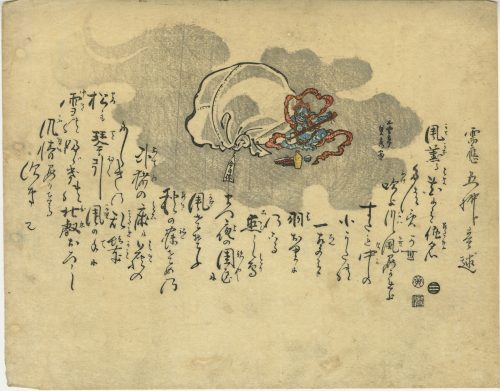 Artist: Utagawa Sadahide [歌川 貞秀], a.k.a. Gountei Sadahide [五雲亭 貞秀] (Japanese, 1807 – c. 1878-9). Publisher: Ibaya Senzaburō [伊場屋仙三郎] (Japanese, c. 1815 – 1869). Date-kiwame seal: 1831 (Tenpō 2). Size: Uchiwa-e, 298 x 232 mm. Pair of uncut fan prints (1) with the god of wind and (2) with the god of thunder meant to be pasted on two sides of a fan.
Artist: Utagawa Sadahide [歌川 貞秀], a.k.a. Gountei Sadahide [五雲亭 貞秀] (Japanese, 1807 – c. 1878-9). Publisher: Ibaya Senzaburō [伊場屋仙三郎] (Japanese, c. 1815 – 1869). Date-kiwame seal: 1831 (Tenpō 2). Size: Uchiwa-e, 298 x 232 mm. Pair of uncut fan prints (1) with the god of wind and (2) with the god of thunder meant to be pasted on two sides of a fan.

-
 Artist: Utagawa Yoshitsuya [歌川 芳艶] (Japanese, 1822 – 1866). Publisher: Kojimaya Jūbei [小島屋重兵衛] (Japanese, c. 1797 – 1869). Date seal and double nanushi censor seals: Kunigasa & Yoshimura, Kōka 5 (1849). Signed: Ichieisai Yoshitsuya ga [英斎芳艶画] in a red double gourd cartouche. Two men are fishing with a net off the coast of Shinagawa, in the Edo Bay.
Artist: Utagawa Yoshitsuya [歌川 芳艶] (Japanese, 1822 – 1866). Publisher: Kojimaya Jūbei [小島屋重兵衛] (Japanese, c. 1797 – 1869). Date seal and double nanushi censor seals: Kunigasa & Yoshimura, Kōka 5 (1849). Signed: Ichieisai Yoshitsuya ga [英斎芳艶画] in a red double gourd cartouche. Two men are fishing with a net off the coast of Shinagawa, in the Edo Bay. -
 Artist: Utagawa Kunimaru [歌川国丸] (Japanese, 1794 – 1829). Publisher: Ibaya Senzaburō [伊場屋 仙三郎] (fl. 1815 – 1869). Date-kiwame seal: Bunsei 10 (1827). Signed: Ichiensai Kunimaru ga [一円斎国丸画]. Play: Chūshingura [忠臣蔵] (The Treasury of Loyal Retainers), 11th act, Night Battle [十一段目夜討之図]. Act XI: The Attack on Kō no Moronao Mansion. Kō no Moronao [高 師直] (Japanese, d. 1351). Ref: Ako City Museum of History Inscription on the soba peddler box: Nihachi soba udon [二八そば うどん] – twice eight soba and udon (16 mon per serving).
Artist: Utagawa Kunimaru [歌川国丸] (Japanese, 1794 – 1829). Publisher: Ibaya Senzaburō [伊場屋 仙三郎] (fl. 1815 – 1869). Date-kiwame seal: Bunsei 10 (1827). Signed: Ichiensai Kunimaru ga [一円斎国丸画]. Play: Chūshingura [忠臣蔵] (The Treasury of Loyal Retainers), 11th act, Night Battle [十一段目夜討之図]. Act XI: The Attack on Kō no Moronao Mansion. Kō no Moronao [高 師直] (Japanese, d. 1351). Ref: Ako City Museum of History Inscription on the soba peddler box: Nihachi soba udon [二八そば うどん] – twice eight soba and udon (16 mon per serving). -
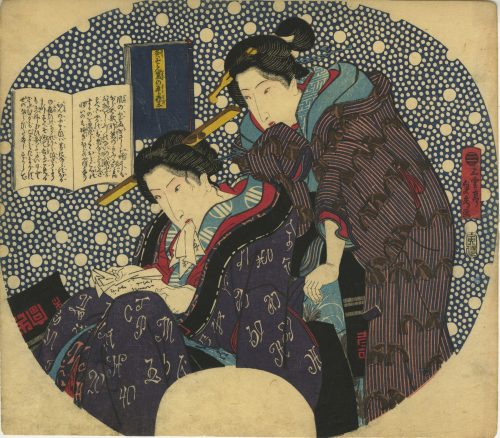 Artist: Utagawa Sadahide [歌川 貞秀], a.k.a. Gountei Sadahide [五雲亭 貞秀] (1807 – c. 1878/9). Signed: Gountei Sadahide ga [五雲亭貞秀画] Pubisher: Ibaya Senzaburō [伊場屋仙三郎] (Japanese, 1815 – 1869) Date-aratame seal: Bunsei 13 / Tenpō 1 (1830). Ref: Ritsumeikan University # Z0172-587. Title: The tatami night robe of Iwao [巌の畳夜着] (Kyusue Iwao no tatami yogi); 灸すゑ巌の畳夜着(きゅうすえいわおのたたみよぎ。「灸すえ」– one of the main melodies in katōbushi (河東節) type of jōruri [浄瑠璃]. For a detailed explanation in Japanese, see also HERE). The night robe of Iwao is decorated with characters resembling Arabic numerals, and Latin and Cyrillic letters. A similar kimono can be seen on Kunisada's print Hotoke Gozen, Mirror of Virtuous and Wise Women (Kenjo Kagami) at RISD museum accession number 13.1383, portraying Hotoke Gozen (佛御前), a character of The Tale of the Heike [平家物語] (Heike Monogatari); published by Yamamotoya Heikichi (山本屋平吉) (Japanese, fl. c. 1812 – 1886) in the 1830s (see below).A series of three prints is dedicated to a katōbushi performance of the Soga-themed plays.
Artist: Utagawa Sadahide [歌川 貞秀], a.k.a. Gountei Sadahide [五雲亭 貞秀] (1807 – c. 1878/9). Signed: Gountei Sadahide ga [五雲亭貞秀画] Pubisher: Ibaya Senzaburō [伊場屋仙三郎] (Japanese, 1815 – 1869) Date-aratame seal: Bunsei 13 / Tenpō 1 (1830). Ref: Ritsumeikan University # Z0172-587. Title: The tatami night robe of Iwao [巌の畳夜着] (Kyusue Iwao no tatami yogi); 灸すゑ巌の畳夜着(きゅうすえいわおのたたみよぎ。「灸すえ」– one of the main melodies in katōbushi (河東節) type of jōruri [浄瑠璃]. For a detailed explanation in Japanese, see also HERE). The night robe of Iwao is decorated with characters resembling Arabic numerals, and Latin and Cyrillic letters. A similar kimono can be seen on Kunisada's print Hotoke Gozen, Mirror of Virtuous and Wise Women (Kenjo Kagami) at RISD museum accession number 13.1383, portraying Hotoke Gozen (佛御前), a character of The Tale of the Heike [平家物語] (Heike Monogatari); published by Yamamotoya Heikichi (山本屋平吉) (Japanese, fl. c. 1812 – 1886) in the 1830s (see below).A series of three prints is dedicated to a katōbushi performance of the Soga-themed plays.
RISDM 13-1383
They all have a background of hail patterns (Arare-ko-mon) [霰小紋], similar to Kunisada’s Iwai Kumesaburō II as An no Heibei [SVJP-0304.2019], see below.Yukari no Edo-zakura The tatami night robe of Iwao Tangled Hair and the Evening Braided Hat 
-
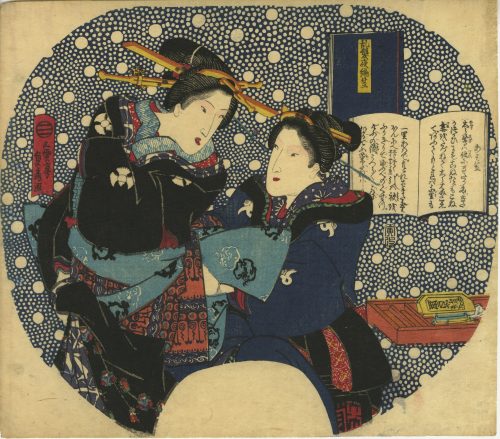 Artist: Utagawa Sadahide [歌川 貞秀], a.k.a. Gountei Sadahide [五雲亭 貞秀] (1807 – c. 1878/9). Signed: Gountei Sadahide ga [五雲亭貞秀画] Pubisher: Ibaya Senzaburō [伊場屋仙三郎] (Japanese, 1815 – 1869) Date-aratame seal: Bunsei 13 / Tenpō 1 (1830). Ref: Ritsumeikan University # Z0172-587. Title: Tangled Hair and the Evening Braided Hat [乱髪夜編笠] (Midaregami Yoru no Amigasa). The open book starts with the chapter title that reads Amigasa. This play was performed together with Kisohajime Hatsugai Soga [着衣始]初買曽我]. See the playbill for the performance at Moritaza at MFA (Boston) № 11.27208. 乱髪夜編笠(みだれがみよるのあみがさ。「夜の編笠」「白さぎ」
Artist: Utagawa Sadahide [歌川 貞秀], a.k.a. Gountei Sadahide [五雲亭 貞秀] (1807 – c. 1878/9). Signed: Gountei Sadahide ga [五雲亭貞秀画] Pubisher: Ibaya Senzaburō [伊場屋仙三郎] (Japanese, 1815 – 1869) Date-aratame seal: Bunsei 13 / Tenpō 1 (1830). Ref: Ritsumeikan University # Z0172-587. Title: Tangled Hair and the Evening Braided Hat [乱髪夜編笠] (Midaregami Yoru no Amigasa). The open book starts with the chapter title that reads Amigasa. This play was performed together with Kisohajime Hatsugai Soga [着衣始]初買曽我]. See the playbill for the performance at Moritaza at MFA (Boston) № 11.27208. 乱髪夜編笠(みだれがみよるのあみがさ。「夜の編笠」「白さぎ」とも)– one of the main melodies in katōbushi (河東節) type of jōruri [浄瑠璃]. For a detailed explanation in Japanese, see also HERE). A series of three prints is dedicated to a katōbushi performance of the Soga-themed plays.
They all have a background of hail patterns (Arare-ko-mon) [霰小紋], similar to Kunisada’s Iwai Kumesaburō II as An no Heibei [SVJP-0304.2019], see below.Yukari no Edo-zakura The tatami night robe of Iwao Tangled Hair and the Evening Braided Hat 
-
 Artist: Utagawa Sadahide [歌川 貞秀], a.k.a. Gountei Sadahide [五雲亭 貞秀] (1807 – c. 1878/9). Signed: Gountei Sadahide ga [五雲亭貞秀画] Pubisher: Ibaya Senzaburō [伊場屋仙三郎] (Japanese, 1815 – 1869) Date-aratame seal: Bunsei 13 / Tenpō 1 (1830). Ref: Ritsumeikan University # Z0172-587. Title: Yukari no Edo-zakura [ゆかりの江戸桜], often translated into English as 'The Flower of Edo', is a one-act kabuki play Sukeroku, written by Tsuuchi Han'emon (fl. 1701 – 1743) under the supervision of Tsuuchi Jihei II (1673 – 1760 ) at the beginning of the 18th century. From the beginning of the 19th century, the play was performed in the style of katōbushi. 助六所縁江戸桜(すけろくゆかりのえどざくら。「助六」– one of the main melodies in katōbushi (河東節) type of jōruri [浄瑠璃]. For a detailed explanation in Japanese, see also HERE). Plot: In search of the stolen Minamoto clan's precious sword called Tomokirimaru, Soga Gorō (historical Soga Tokimune [曾我時致], 1174 – 1193) came to a Yoshiwara brothel under the disguise of a debaucher named Hanagawado Sukeroku. His elder brother, Soga Jūrō (historical Soga Sukenari [曾我祐成], 1172 – 1193) ), has assumed the guise of a wine vendor Shinbei. The character who had the Tomokirimaru sword was Ikyū (historical Iga no Heinaizaemon, a Tiara clan's ally), see SVJP-0164.2014. A series of three prints is dedicated to a katōbushi performance of the Soga-themed plays.
Artist: Utagawa Sadahide [歌川 貞秀], a.k.a. Gountei Sadahide [五雲亭 貞秀] (1807 – c. 1878/9). Signed: Gountei Sadahide ga [五雲亭貞秀画] Pubisher: Ibaya Senzaburō [伊場屋仙三郎] (Japanese, 1815 – 1869) Date-aratame seal: Bunsei 13 / Tenpō 1 (1830). Ref: Ritsumeikan University # Z0172-587. Title: Yukari no Edo-zakura [ゆかりの江戸桜], often translated into English as 'The Flower of Edo', is a one-act kabuki play Sukeroku, written by Tsuuchi Han'emon (fl. 1701 – 1743) under the supervision of Tsuuchi Jihei II (1673 – 1760 ) at the beginning of the 18th century. From the beginning of the 19th century, the play was performed in the style of katōbushi. 助六所縁江戸桜(すけろくゆかりのえどざくら。「助六」– one of the main melodies in katōbushi (河東節) type of jōruri [浄瑠璃]. For a detailed explanation in Japanese, see also HERE). Plot: In search of the stolen Minamoto clan's precious sword called Tomokirimaru, Soga Gorō (historical Soga Tokimune [曾我時致], 1174 – 1193) came to a Yoshiwara brothel under the disguise of a debaucher named Hanagawado Sukeroku. His elder brother, Soga Jūrō (historical Soga Sukenari [曾我祐成], 1172 – 1193) ), has assumed the guise of a wine vendor Shinbei. The character who had the Tomokirimaru sword was Ikyū (historical Iga no Heinaizaemon, a Tiara clan's ally), see SVJP-0164.2014. A series of three prints is dedicated to a katōbushi performance of the Soga-themed plays.
They all have a background of hail patterns (Arare-ko-mon) [霰小紋], similar to Kunisada’s Iwai Kumesaburō II as An no Heibei [SVJP-0304.2019], see below.Yukari no Edo-zakura The tatami night robe of Iwao Tangled Hair and the Evening Braided Hat 
-
 Title: Lyon Collection: Genji, Chapter 21, the maiden (otome - 乙女): the nine-tailed fox woman (kayō-fujin [花陽夫人]) terrorizing Prince Hanzoku (足王) and his servant from the series Japanese and Chinese parallels to Genji (wakan nazorae genji - 和漢准源氏). British Museum: Otome 乙女 (Maiden) / Waken nazorae Genji 和漢准源氏 (Japanese and Chinese Comparisons for the Chapters of the Genji). Schaap: Prince Hanzoku terrorized by a nine-tailed fox; Series: Wakan nazorae Genji (Japanese and Chinese parallels to Genji) Artist: Utagawa Kuniyoshi [歌川 國芳] (1798 – 1861). Publisher: Iseyoshi [伊勢芳] (Marks 25-013 | U095); seal [イせ芳]. Block carver: Hori Shōji [彫庄治] (Lyon Collection; BM); Hori Takichi [彫多吉] (Schaap). Date-aratame seal: Ansei 2, 7th month (1855). Ref: Jack Hillier. Japanese prints and drawings from the Vever Collection (3 volumes). — New York: Sotheby Parke Bernet & Rizzoli International, 1976; vol.3, p. 868, pl. 847. Robinson (1982): p. 161, S88, № 21. Schaap (1998): p. 115, № 107. SOLD
Title: Lyon Collection: Genji, Chapter 21, the maiden (otome - 乙女): the nine-tailed fox woman (kayō-fujin [花陽夫人]) terrorizing Prince Hanzoku (足王) and his servant from the series Japanese and Chinese parallels to Genji (wakan nazorae genji - 和漢准源氏). British Museum: Otome 乙女 (Maiden) / Waken nazorae Genji 和漢准源氏 (Japanese and Chinese Comparisons for the Chapters of the Genji). Schaap: Prince Hanzoku terrorized by a nine-tailed fox; Series: Wakan nazorae Genji (Japanese and Chinese parallels to Genji) Artist: Utagawa Kuniyoshi [歌川 國芳] (1798 – 1861). Publisher: Iseyoshi [伊勢芳] (Marks 25-013 | U095); seal [イせ芳]. Block carver: Hori Shōji [彫庄治] (Lyon Collection; BM); Hori Takichi [彫多吉] (Schaap). Date-aratame seal: Ansei 2, 7th month (1855). Ref: Jack Hillier. Japanese prints and drawings from the Vever Collection (3 volumes). — New York: Sotheby Parke Bernet & Rizzoli International, 1976; vol.3, p. 868, pl. 847. Robinson (1982): p. 161, S88, № 21. Schaap (1998): p. 115, № 107. SOLD -
 Artist: Utagawa Kunisada [歌川 国貞]; a.k.a. Utagawa Toyokuni III [三代歌川豊国] (Japanese, 1786 – 1865). Signed: Toyokuni ga [豊国 画] in a red toshidama cartouche. Publisher: Ibaya Senzaburō [伊場屋仙三郎] (Japanese, fl. C. 1845 – 1847), seal: San [三] (Marks 11-001 | 127c). Block carver: Matsushima Fusajirō [松嶋房次郎] (Japanese, fl. 1843 – 1850); seal [彫工房] – Hori kō Fusa (Gordon Friese № 134). Double nanushi censor seal: Kunigasa & Watanabe (1849-50). Actor: Iwai Hanshirō VIII [岩井半四郎] (Japanese, 1829 – 1882); other names: Iwai Shijaku II, Iwai Kumesaburō III [岩井粂三郎], Iwai Hisajirō II. Play: Yukari no Hana Iro mo Yoshiwara [紫花色吉原], performed at the Kawarazaki Theater (Edo) from the 5th day of the 5th lunar month of Kaei 3 (1850) (see Kabuki Playbill at MFA (Boston) № 11.27996).
Artist: Utagawa Kunisada [歌川 国貞]; a.k.a. Utagawa Toyokuni III [三代歌川豊国] (Japanese, 1786 – 1865). Signed: Toyokuni ga [豊国 画] in a red toshidama cartouche. Publisher: Ibaya Senzaburō [伊場屋仙三郎] (Japanese, fl. C. 1845 – 1847), seal: San [三] (Marks 11-001 | 127c). Block carver: Matsushima Fusajirō [松嶋房次郎] (Japanese, fl. 1843 – 1850); seal [彫工房] – Hori kō Fusa (Gordon Friese № 134). Double nanushi censor seal: Kunigasa & Watanabe (1849-50). Actor: Iwai Hanshirō VIII [岩井半四郎] (Japanese, 1829 – 1882); other names: Iwai Shijaku II, Iwai Kumesaburō III [岩井粂三郎], Iwai Hisajirō II. Play: Yukari no Hana Iro mo Yoshiwara [紫花色吉原], performed at the Kawarazaki Theater (Edo) from the 5th day of the 5th lunar month of Kaei 3 (1850) (see Kabuki Playbill at MFA (Boston) № 11.27996). A famous Yoshiwara courtesan named Manjiya Yatsuhashi [万字屋 八ツ橋] was killed by a provincial commoner Sano Jirōzaemon [佐野次郎左衛門] (on the second sheet of the pair):
A famous Yoshiwara courtesan named Manjiya Yatsuhashi [万字屋 八ツ橋] was killed by a provincial commoner Sano Jirōzaemon [佐野次郎左衛門] (on the second sheet of the pair):
Another Kunisada's print with the same characters in the same play and same performance can be seen at MFA (Boston) № 11.40190.
SVJP-0298.2019: Ichikawa Ebizō V as Sano Jirōzaemon.

SVJP-0297.2019: Iwai Kumesaburō III as Manjiya Yatsuhashi
 One more example can be seen in the two upper images at Waseda University Cultural Resources Database, № 006-2707:
One more example can be seen in the two upper images at Waseda University Cultural Resources Database, № 006-2707:

-
 Series: Pictures Associated with the Iroha Syllabary [伊呂波画合]. Artist: Utagawa Kuniyoshi [歌川 國芳] (1798 – 1861). Signed: Ichiyûsai Kuniyoshi giga [一勇斎 國芳戯画] (Playfully drawn by Ichiyūsai Kuniyoshi) in a red double-gourd cartouche with a kiri-mon seal beneath. Publisher: Iseya Ichiemon [伊勢屋市右衛門] (Japanese, fl. 1823 – c. 1864); seal [辻] (Marks 16-029 | 143a). Single nanushi censor seal: Mura [村] = Murata Sahei [村田佐右衛] (VI/1842 – V/1846). Media: Fan print (uchiwa-e, 団扇絵), 231 x 296 mm. Theme: The Treasury of Loyal Retainers [仮名手本忠臣蔵] (Kanadehon Chūshingura) – an 11-act puppet play composed in 1748, based on a historical event. "Most historians now agree that there were forty-seven rōnin of Ako who attacked and killed Kira Yoshinaka (吉良 義央, 1641 – 1703) in Edo in the twelfth month of 1702, twenty-two months after their lord Asano Naganori (浅野 長矩, 1667 – 1701) had been put to death for his own failed attempt on Kira’s life". [Henry D. SMITH II. The Trouble with Terasaka: The Forty-Seventh Rōnin and the Chūshingura Imagination / Japan Review, 2004, 16:3-65]. The reader shall remember that the fictional, romantic version of the Akō incident [赤穂事件] (Akō jiken) may not (and most probably does not) reflect the historical truth of events. Uncut fan print depicting a beautiful young woman covering another woman's mouth with a blue striped cloth, possibly an obi. The picture on the wall represents the scene from the final act of The Treasury of Loyal Retainers (Kanadehon Chūshingura, Act 11) when 47 loyal retainers (rōnin) of the late lord En'ya Hangan came to the house of Kō no Moronao in order to avenge their dead master. The leader of 47 rōnin, Ōboshi Yuranosuke, divided his accomplices into several groups which attacked the Moronao mansion from different directions. To coordinate the attack and keep communication among the groups, the rōnin were signing the first syllables of their names in the hiragana syllabary. There are two major types of the ordering of the hiragana syllabary, the Gojūon one and the Iroha order (pangram poem), the latter being used here. The number of avengers exactly matches the 47 letters of that syllabary. The group entering Moronao's house from the front gate was 'chi-ri-nu-ru-wo-wa-ka'. Yoshida Sadaemon Kanesada [葦田貞右衛門兼貞] (1675 – 1703) depicted on this fan print belongs to this group. The character on the lantern hanging from Yoshida's spear reads Chū [忠] – for Chūshingura. Alternating black and white triangles on the picture frame allude to the 'signature' 47 ronin's uniform. This motif is usually described as a zigzag pattern [雁木模様] (gangi moyō), a mountain-shaped pattern [山形模様] (yamagata moyō), or a mountain road [山道] (yamamichi). The rōnin were allegedly wearing this uniform in imitation of firefighters. The government allowed the firefighters alone to gather in large groups and carry equipment akin to that of the military. Such equipment was necessary for firemen to tear down the burning buildings to stop the flames. The design can be seen in Kunimaru's fan print [SVJP-0233.2018] in this collection.Fighting Moronao's guards, the 47 rōnin entered the mansion and searched for their enemy but in vain. Finally, Yazama Jujiro Motooki [矢間重次郎元興] found the villain in the charcoal chamber and called his friends. This is the exact moment we see in the picture on the wall: Yoshida entering the charcoal chamber with a spear in his hand amid falling baskets and charcoal. Kō no Moronao was brought to justice and beheaded; his head was offered before the memorial tablet of En'ya Hangan to appease his spirit. After that, Ōboshi Yuranosuke and his 46 friends committed seppuku. They were buried at Sengakuji (泉岳寺) – a small temple near Shinagawa in Edo (Tokyo).
Series: Pictures Associated with the Iroha Syllabary [伊呂波画合]. Artist: Utagawa Kuniyoshi [歌川 國芳] (1798 – 1861). Signed: Ichiyûsai Kuniyoshi giga [一勇斎 國芳戯画] (Playfully drawn by Ichiyūsai Kuniyoshi) in a red double-gourd cartouche with a kiri-mon seal beneath. Publisher: Iseya Ichiemon [伊勢屋市右衛門] (Japanese, fl. 1823 – c. 1864); seal [辻] (Marks 16-029 | 143a). Single nanushi censor seal: Mura [村] = Murata Sahei [村田佐右衛] (VI/1842 – V/1846). Media: Fan print (uchiwa-e, 団扇絵), 231 x 296 mm. Theme: The Treasury of Loyal Retainers [仮名手本忠臣蔵] (Kanadehon Chūshingura) – an 11-act puppet play composed in 1748, based on a historical event. "Most historians now agree that there were forty-seven rōnin of Ako who attacked and killed Kira Yoshinaka (吉良 義央, 1641 – 1703) in Edo in the twelfth month of 1702, twenty-two months after their lord Asano Naganori (浅野 長矩, 1667 – 1701) had been put to death for his own failed attempt on Kira’s life". [Henry D. SMITH II. The Trouble with Terasaka: The Forty-Seventh Rōnin and the Chūshingura Imagination / Japan Review, 2004, 16:3-65]. The reader shall remember that the fictional, romantic version of the Akō incident [赤穂事件] (Akō jiken) may not (and most probably does not) reflect the historical truth of events. Uncut fan print depicting a beautiful young woman covering another woman's mouth with a blue striped cloth, possibly an obi. The picture on the wall represents the scene from the final act of The Treasury of Loyal Retainers (Kanadehon Chūshingura, Act 11) when 47 loyal retainers (rōnin) of the late lord En'ya Hangan came to the house of Kō no Moronao in order to avenge their dead master. The leader of 47 rōnin, Ōboshi Yuranosuke, divided his accomplices into several groups which attacked the Moronao mansion from different directions. To coordinate the attack and keep communication among the groups, the rōnin were signing the first syllables of their names in the hiragana syllabary. There are two major types of the ordering of the hiragana syllabary, the Gojūon one and the Iroha order (pangram poem), the latter being used here. The number of avengers exactly matches the 47 letters of that syllabary. The group entering Moronao's house from the front gate was 'chi-ri-nu-ru-wo-wa-ka'. Yoshida Sadaemon Kanesada [葦田貞右衛門兼貞] (1675 – 1703) depicted on this fan print belongs to this group. The character on the lantern hanging from Yoshida's spear reads Chū [忠] – for Chūshingura. Alternating black and white triangles on the picture frame allude to the 'signature' 47 ronin's uniform. This motif is usually described as a zigzag pattern [雁木模様] (gangi moyō), a mountain-shaped pattern [山形模様] (yamagata moyō), or a mountain road [山道] (yamamichi). The rōnin were allegedly wearing this uniform in imitation of firefighters. The government allowed the firefighters alone to gather in large groups and carry equipment akin to that of the military. Such equipment was necessary for firemen to tear down the burning buildings to stop the flames. The design can be seen in Kunimaru's fan print [SVJP-0233.2018] in this collection.Fighting Moronao's guards, the 47 rōnin entered the mansion and searched for their enemy but in vain. Finally, Yazama Jujiro Motooki [矢間重次郎元興] found the villain in the charcoal chamber and called his friends. This is the exact moment we see in the picture on the wall: Yoshida entering the charcoal chamber with a spear in his hand amid falling baskets and charcoal. Kō no Moronao was brought to justice and beheaded; his head was offered before the memorial tablet of En'ya Hangan to appease his spirit. After that, Ōboshi Yuranosuke and his 46 friends committed seppuku. They were buried at Sengakuji (泉岳寺) – a small temple near Shinagawa in Edo (Tokyo).
Utagawa Kunimaru. Chūshingura, Act 11.
 Another fan print from the same series can be found at Kuniyoshi Project:
Another fan print from the same series can be found at Kuniyoshi Project:
 The same subject is portrayed by Kuniyoshi in the series Mirror of the True Loyalty of the Faithful Retainers [誠忠義臣鏡] (Seichû gishin kagami), publisher: Kagiya Hanjirô, c. 1851 (Kuniyoshi Project) – Yoshida Sadaemon Kanesada (葦田貞右衛門兼貞) raising his sword amid falling baskets and charcoal:
The same subject is portrayed by Kuniyoshi in the series Mirror of the True Loyalty of the Faithful Retainers [誠忠義臣鏡] (Seichû gishin kagami), publisher: Kagiya Hanjirô, c. 1851 (Kuniyoshi Project) – Yoshida Sadaemon Kanesada (葦田貞右衛門兼貞) raising his sword amid falling baskets and charcoal:

-
 Artist: Tsukioka Tanka [旦霞] (Japanese, fl. c. 1830s – 1840s). Publisher: Enshūya Matabei [遠州屋又兵衛] (Japanese, fl. c. 1768 – 1881); seal: Enmata. Title: Picture of Fuji, Tsukuba and Sumida River [富士筑波隅田川の圖] (フジ ツクバ スミダガワ ノ ズ | Fuji Tsukuba Sumidagawa no zu). Date seal 巳 + kiwame: Tenpō 4 (1833). Media: Fan print (uchiwa-e, 団扇絵), 235 x 302 mm, aizuri-e. Only four prints are known from this artist, all fans: (1) National Diet Library 2542868:
Artist: Tsukioka Tanka [旦霞] (Japanese, fl. c. 1830s – 1840s). Publisher: Enshūya Matabei [遠州屋又兵衛] (Japanese, fl. c. 1768 – 1881); seal: Enmata. Title: Picture of Fuji, Tsukuba and Sumida River [富士筑波隅田川の圖] (フジ ツクバ スミダガワ ノ ズ | Fuji Tsukuba Sumidagawa no zu). Date seal 巳 + kiwame: Tenpō 4 (1833). Media: Fan print (uchiwa-e, 団扇絵), 235 x 302 mm, aizuri-e. Only four prints are known from this artist, all fans: (1) National Diet Library 2542868:
(2) Ritsumeikan University mai30_07:

 (3) RISD Museum 34.334:
(3) RISD Museum 34.334:

-
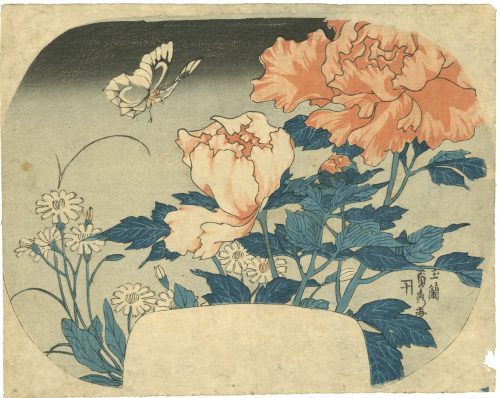 Artist: Utagawa Sadahide [歌川貞秀] (Japanese, 1807 – 1879) Publisher: Kojimaya Jūbei [小島屋重兵衛] (Japanese, c. 1797 – 1869) No date seal, no censor seal (privately printed?) Media: Fan print (uchiwa-e, 団扇絵), 235 x 297 mm. Kalimeris incisa, or Japanese Aster, is a daisy-like flower that belongs to the family of Asteraceae; it blossoms all summer and attracts butterflies. Peony [牡丹] (botan) – per Merrily Baird it is "the king of flowers", associated with erotic love, and especially with the sexual activities of women.
Artist: Utagawa Sadahide [歌川貞秀] (Japanese, 1807 – 1879) Publisher: Kojimaya Jūbei [小島屋重兵衛] (Japanese, c. 1797 – 1869) No date seal, no censor seal (privately printed?) Media: Fan print (uchiwa-e, 団扇絵), 235 x 297 mm. Kalimeris incisa, or Japanese Aster, is a daisy-like flower that belongs to the family of Asteraceae; it blossoms all summer and attracts butterflies. Peony [牡丹] (botan) – per Merrily Baird it is "the king of flowers", associated with erotic love, and especially with the sexual activities of women. -
 Artist: Utagawa Hiroshige II (二代目 歌川広重] (Japanese, 1826 – 1869). Signed: Hiroshige ga. Publisher: Iseya Sōemon [伊勢屋惣右衛門] (Japanese, c. 1776 – 1862); seal: Hanmoto, Ue [板元 上] (Marks 19-047 | 156d). Combined date seal and kiwame censor seal: Bunkyū 2 (1862) Media: Fan print (uchiwa-e, 団扇絵), 230 x 296 mm.
Artist: Utagawa Hiroshige II (二代目 歌川広重] (Japanese, 1826 – 1869). Signed: Hiroshige ga. Publisher: Iseya Sōemon [伊勢屋惣右衛門] (Japanese, c. 1776 – 1862); seal: Hanmoto, Ue [板元 上] (Marks 19-047 | 156d). Combined date seal and kiwame censor seal: Bunkyū 2 (1862) Media: Fan print (uchiwa-e, 団扇絵), 230 x 296 mm. -
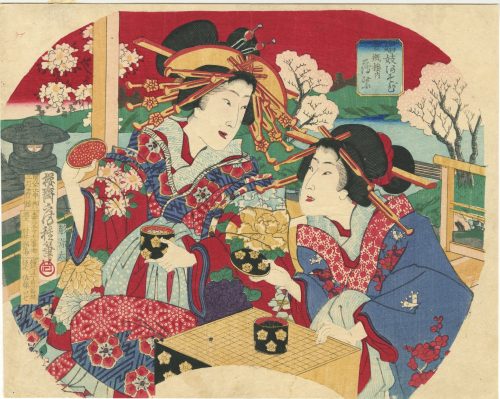 Artist: Utagawa Fusatane [歌川 房種] (Japanese, fl. 1854 – 1889), other names: Ippyosai; Isshosai; Murai Seima; Utagawa Seimas; Osai; Signed: Ōsai Fusatane Hitsu [桜斎房種筆] in a cartouche, with a round stamp. Block carver: Watanabe Yatarō (Japanese, 1850 – 1913); seal [彫弥太] – Hori Yata (Friese 2009b: 117). Publisher [板元] (Hammoto): Satō Ise [佐藤いせ], address: Horiechō, Nichōme, ichi-banchi [堀江町二丁目一番地] Publication date [御届] (otodoke): Meiji 10th year, 3rd month, 22nd day (1877). Artist [画工] (Gakō): Murai Seima [村井 静馬], address: Honjo-Sotodechō, 18 [本所外手丁十八番地]. Uncut fan print (uchiwa-e), 236 x 297 mm, depicting two harlots or courtesans playing [娼妓あそび] (shōgi asobi) go game in the famous Kinpeiro [金瓶楼内] brothel in New Yoshiwara in Tokyo. In the courtesan's name, the second character seems to be 紫 (Murasaki); the first character is unclear, so we do not know her name yet.
Artist: Utagawa Fusatane [歌川 房種] (Japanese, fl. 1854 – 1889), other names: Ippyosai; Isshosai; Murai Seima; Utagawa Seimas; Osai; Signed: Ōsai Fusatane Hitsu [桜斎房種筆] in a cartouche, with a round stamp. Block carver: Watanabe Yatarō (Japanese, 1850 – 1913); seal [彫弥太] – Hori Yata (Friese 2009b: 117). Publisher [板元] (Hammoto): Satō Ise [佐藤いせ], address: Horiechō, Nichōme, ichi-banchi [堀江町二丁目一番地] Publication date [御届] (otodoke): Meiji 10th year, 3rd month, 22nd day (1877). Artist [画工] (Gakō): Murai Seima [村井 静馬], address: Honjo-Sotodechō, 18 [本所外手丁十八番地]. Uncut fan print (uchiwa-e), 236 x 297 mm, depicting two harlots or courtesans playing [娼妓あそび] (shōgi asobi) go game in the famous Kinpeiro [金瓶楼内] brothel in New Yoshiwara in Tokyo. In the courtesan's name, the second character seems to be 紫 (Murasaki); the first character is unclear, so we do not know her name yet. -
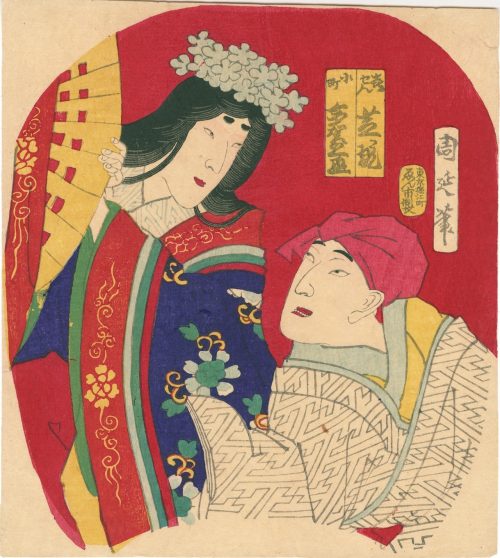 Artist: Toyohara Chikanobu [豊原周延] (Japanese, 1838 – 1912) Signed: Chikanobu hitsu [周延筆] Publisher: [ 東京掘江町] Tokyo Horiemachi | [えん市製] Enshi-sei. Media: Fan print (uchiwa-e, 団扇絵), 192 x 172 mm. Possibly Iwai Kumesaburō IV [岩井粂三郎] (1856 – 1886) a.k.a. Iwai Hisajirō III [岩井久次郎] in the role of Ono no Komachi [小野乃小町] and Nakamura Shikan IV [中村芝翫] in the role of Kisen Hōshi [喜せん法師]. Play: The Six Immortal Poets in Colorful Guises [六歌仙体綵] (Rokkasen Sugata no irodori). Inscription: Left: Kisen [喜せん] | Shikan [芝翫] Right: Komachi [小町] | Kumesaburō [粂三郎]. Actors: Iwai Kumesaburō IV [岩井粂三郎] (1856 – 1886) a.k.a. Iwai Hisajirō III [岩井久次郎]. Nakamura Shikan IV [中村芝翫] (Japanese, 1831 – 1899); other names: Nakamura Fukusuke I [中村福助], Nakamura Masanosuke I, Nakamura Komasaburō, Nakamura Tamatarō I.
Artist: Toyohara Chikanobu [豊原周延] (Japanese, 1838 – 1912) Signed: Chikanobu hitsu [周延筆] Publisher: [ 東京掘江町] Tokyo Horiemachi | [えん市製] Enshi-sei. Media: Fan print (uchiwa-e, 団扇絵), 192 x 172 mm. Possibly Iwai Kumesaburō IV [岩井粂三郎] (1856 – 1886) a.k.a. Iwai Hisajirō III [岩井久次郎] in the role of Ono no Komachi [小野乃小町] and Nakamura Shikan IV [中村芝翫] in the role of Kisen Hōshi [喜せん法師]. Play: The Six Immortal Poets in Colorful Guises [六歌仙体綵] (Rokkasen Sugata no irodori). Inscription: Left: Kisen [喜せん] | Shikan [芝翫] Right: Komachi [小町] | Kumesaburō [粂三郎]. Actors: Iwai Kumesaburō IV [岩井粂三郎] (1856 – 1886) a.k.a. Iwai Hisajirō III [岩井久次郎]. Nakamura Shikan IV [中村芝翫] (Japanese, 1831 – 1899); other names: Nakamura Fukusuke I [中村福助], Nakamura Masanosuke I, Nakamura Komasaburō, Nakamura Tamatarō I. -
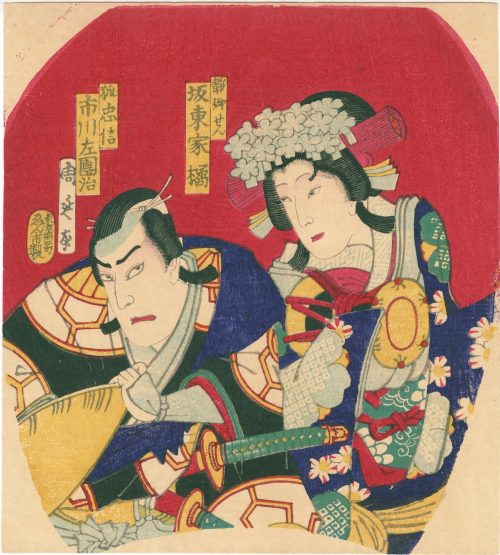 Artist: Toyohara Chikanobu [豊原周延] (Japanese, 1838 – 1912) Signed: Chikanobu ga [周延画] Publisher: [ 東京掘江町] Tokyo Horiemachi | [えん市製] Enshi-sei. Media: Fan print (uchiwa-e, 団扇絵), 192 x 172 mm. Actors: Female: Bandō Kakitsu I in the role of Shizuka Gozen [静御前]. Male: Ichikawa Sadanji I in the role of Kitsune Tadanobu [狐忠信], a.k.a. Satō Tadanobu [佐藤 忠信]. Bandō Kakitsu I [初代 坂東 家橘] (Japanese, 1847 – 1893); other names: Ichimura Kakitsu V, Ichimura Uzaemon XIV, Ichimura Kakitsu V, Ichimura Uzaemon XIV, Ichimura Takematsu III. Ichikawa Sadanji I [市川左団次] (Japanese, 1842 – 1904); other names: Ichikawa Shōjaku I, Ichikawa Koyone, Ichikawa Tatsuzō.
Artist: Toyohara Chikanobu [豊原周延] (Japanese, 1838 – 1912) Signed: Chikanobu ga [周延画] Publisher: [ 東京掘江町] Tokyo Horiemachi | [えん市製] Enshi-sei. Media: Fan print (uchiwa-e, 団扇絵), 192 x 172 mm. Actors: Female: Bandō Kakitsu I in the role of Shizuka Gozen [静御前]. Male: Ichikawa Sadanji I in the role of Kitsune Tadanobu [狐忠信], a.k.a. Satō Tadanobu [佐藤 忠信]. Bandō Kakitsu I [初代 坂東 家橘] (Japanese, 1847 – 1893); other names: Ichimura Kakitsu V, Ichimura Uzaemon XIV, Ichimura Kakitsu V, Ichimura Uzaemon XIV, Ichimura Takematsu III. Ichikawa Sadanji I [市川左団次] (Japanese, 1842 – 1904); other names: Ichikawa Shōjaku I, Ichikawa Koyone, Ichikawa Tatsuzō. -
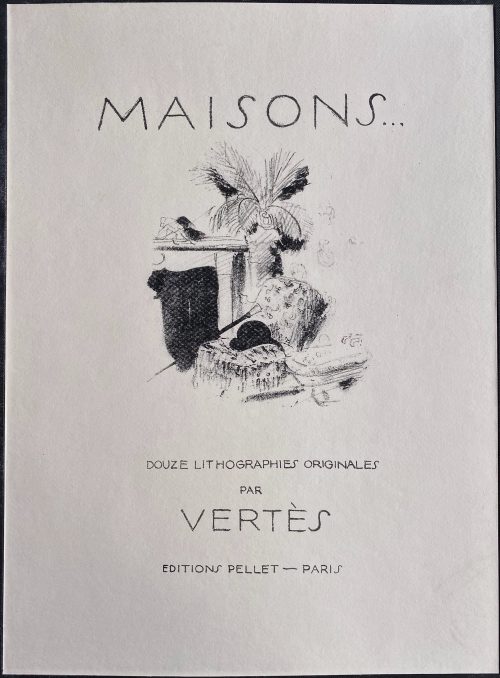 Album in-folio of 13 lithographs by Marcel Vertès, incl. title-page, each in a passe-partout 41.5 x 31.7 cm with 33.0 x 23.0 cm window, printed on wove paper sheets 38.0 x 28.0 cm and crayon-coloured by the artist; graphite pencil drawings by Marcel Vertès on the lower-right corner of each passe-partout; all in a buckram-backed flapped folder, signed ‘AT BOICHOT’, with an uncoloured title-page lithograph on front cover. Edition limited to 100 copies on Chine (№№ 1-100) and 900 on Vélin (№№ 1 to 900); this is a copy № 22 (Vélin), unique as enhanced by the artist. Double-folio leaf 41 x 31 cm with text by Pierre Mac-Orlan. These lithographs, uncoloured, were used in Pierre Mac-Orlan. Les jeux du demi-jour / avec douze lithographies de Vertès. — Paris: Les arts et le livre, 1926 [LIB-2893.2021]. Lithographed title-page: MAISONS.... | {vignette} | DOUZE LITHOGRAPHIES ORIGINALES | PAR | VERTÈS | ÉDITIONS PELLET ~ PARIS || Catalogue raisonné: Vokaer: № 5, p. 7; Nordmann (1): 423, p. 267. Contributors: Pierre Mac-Orlan (French, 1882 – 1970) – author. Marcel Vertès [Marcell Vértes] (Jewish-Hungarian-French, 1895 – 1961) – artist. Gustave Pellet (1859 – 1919) – publisher. Thomas Boichot – bookbinder. Description by J.-P. Dutel: MAC ORLAN Pierre. VERTES Marcel. MAISONS... Douze lithographies originales. Paris, Editions Pellet, [1925]. In-folio (410 x 310 mm) de [4] ff. et 13 lithographies sous passe-partout dont un titre. Chemise en demi-soienoire, premier plat illustré de la même lithographie que celle utilisée pour le titre (AT Boichot). TIRAGE : 100 albums sur chine avant la signature gravée, chaque planche signée. 900 albums sur vélin. :Un des 900 albums sur vélin (n° 22). EXEMPLAIRE UNIQUE DANS LEQUEL LES 13 LITHOGRAPHIES ONT ÉTÉCOLORIÉES AUX CRAYONS DE COULEURS PAR VERTÈS. DE PLUS, CHAQUE PASSE-PARTOUT COMPORTE EN BAS À DROITE UN CROQUIS ORIGINAL À LA MINE DE PLOMB CORRESPONDANT À UNE VERSION PLUS LIBRE DELA LITHO.
Album in-folio of 13 lithographs by Marcel Vertès, incl. title-page, each in a passe-partout 41.5 x 31.7 cm with 33.0 x 23.0 cm window, printed on wove paper sheets 38.0 x 28.0 cm and crayon-coloured by the artist; graphite pencil drawings by Marcel Vertès on the lower-right corner of each passe-partout; all in a buckram-backed flapped folder, signed ‘AT BOICHOT’, with an uncoloured title-page lithograph on front cover. Edition limited to 100 copies on Chine (№№ 1-100) and 900 on Vélin (№№ 1 to 900); this is a copy № 22 (Vélin), unique as enhanced by the artist. Double-folio leaf 41 x 31 cm with text by Pierre Mac-Orlan. These lithographs, uncoloured, were used in Pierre Mac-Orlan. Les jeux du demi-jour / avec douze lithographies de Vertès. — Paris: Les arts et le livre, 1926 [LIB-2893.2021]. Lithographed title-page: MAISONS.... | {vignette} | DOUZE LITHOGRAPHIES ORIGINALES | PAR | VERTÈS | ÉDITIONS PELLET ~ PARIS || Catalogue raisonné: Vokaer: № 5, p. 7; Nordmann (1): 423, p. 267. Contributors: Pierre Mac-Orlan (French, 1882 – 1970) – author. Marcel Vertès [Marcell Vértes] (Jewish-Hungarian-French, 1895 – 1961) – artist. Gustave Pellet (1859 – 1919) – publisher. Thomas Boichot – bookbinder. Description by J.-P. Dutel: MAC ORLAN Pierre. VERTES Marcel. MAISONS... Douze lithographies originales. Paris, Editions Pellet, [1925]. In-folio (410 x 310 mm) de [4] ff. et 13 lithographies sous passe-partout dont un titre. Chemise en demi-soienoire, premier plat illustré de la même lithographie que celle utilisée pour le titre (AT Boichot). TIRAGE : 100 albums sur chine avant la signature gravée, chaque planche signée. 900 albums sur vélin. :Un des 900 albums sur vélin (n° 22). EXEMPLAIRE UNIQUE DANS LEQUEL LES 13 LITHOGRAPHIES ONT ÉTÉCOLORIÉES AUX CRAYONS DE COULEURS PAR VERTÈS. DE PLUS, CHAQUE PASSE-PARTOUT COMPORTE EN BAS À DROITE UN CROQUIS ORIGINAL À LA MINE DE PLOMB CORRESPONDANT À UNE VERSION PLUS LIBRE DELA LITHO. -
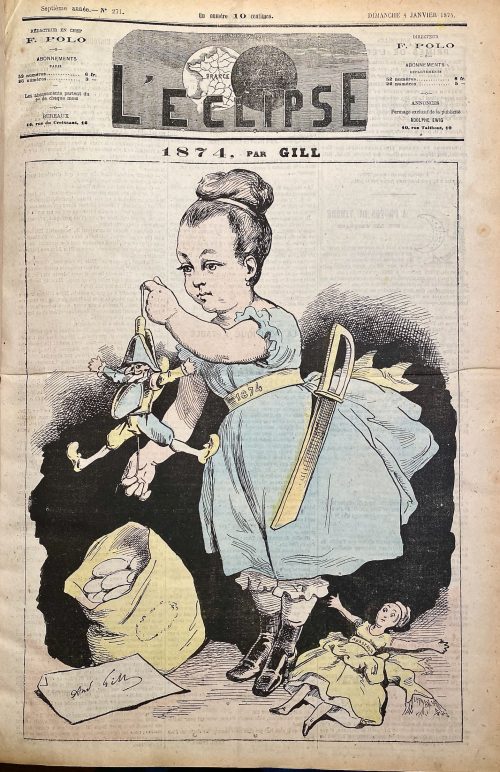 129 issues of L'Éclipse, French weekly political magazine; published in Paris, 49 x 34 cm, bound in rebacked green quarter morocco over marbled boards, with gilt fillets and lettering to spine, peacock marbled endpapers, illustrated by André Gill (French, 1840 – 1885). Founder and editor-in-chief François Polo (French, 1838 – 1874). 1874: 271-322 (52 issues) 1875: 323-374 (52 issues) 1876: 375-399 (25 issues)
129 issues of L'Éclipse, French weekly political magazine; published in Paris, 49 x 34 cm, bound in rebacked green quarter morocco over marbled boards, with gilt fillets and lettering to spine, peacock marbled endpapers, illustrated by André Gill (French, 1840 – 1885). Founder and editor-in-chief François Polo (French, 1838 – 1874). 1874: 271-322 (52 issues) 1875: 323-374 (52 issues) 1876: 375-399 (25 issues) -
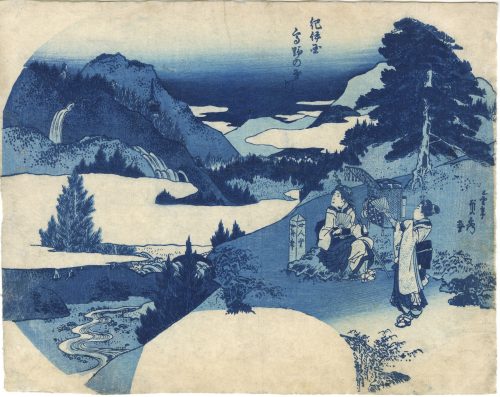 An uncut aizuri fan print showing two travellers admiring the view of the Tama River [多摩川] (Tamagawa) and Mount Kōya [高野山] (Kōyasan) in Kii Province [紀伊国] (Kii no Kuni). Artist: Utagawa Sadahide [歌川貞秀] (Japanese, 1807 – 1879). Signed: Gountei Sadahide ga [五雲亭貞秀画] (Picture by Gountei Sadahide). Publisher: Unknown. Published: c. 1849. No date seal, no censor seal (privately printed?) Media: Fan print [団扇絵] (uchiwa-e), 235 x 300 mm.
An uncut aizuri fan print showing two travellers admiring the view of the Tama River [多摩川] (Tamagawa) and Mount Kōya [高野山] (Kōyasan) in Kii Province [紀伊国] (Kii no Kuni). Artist: Utagawa Sadahide [歌川貞秀] (Japanese, 1807 – 1879). Signed: Gountei Sadahide ga [五雲亭貞秀画] (Picture by Gountei Sadahide). Publisher: Unknown. Published: c. 1849. No date seal, no censor seal (privately printed?) Media: Fan print [団扇絵] (uchiwa-e), 235 x 300 mm. -
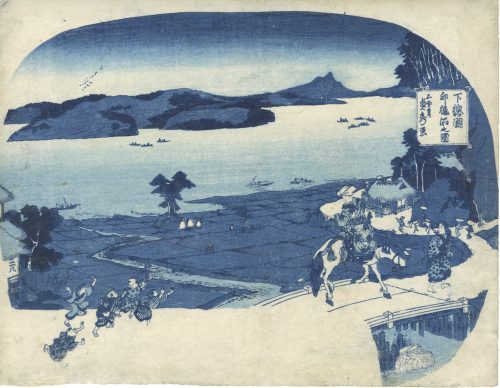 An uncut aizuri fan print showing travellers arriving at Inba Lake [印旛沼] (Inba-numa) on Shimosa Plateau [下総台地] (Shimōsa-daichi). Artist: Utagawa Sadahide [歌川貞秀] (Japanese, 1807 – 1879) Publisher: Unknown. Published: c. 1849. Signed: Gountei Sadahide ga [五雲亭 貞秀画] (Picture by Gountei Sadahide). Inscription in cartouche: Shimosa Plateau, Inbanuma (Inba Lake) [下總國印幡沼]. No date seal, no censor seal (privately printed?) Media: Fan print [団扇絵] (uchiwa-e), 235 x 300 mm.
An uncut aizuri fan print showing travellers arriving at Inba Lake [印旛沼] (Inba-numa) on Shimosa Plateau [下総台地] (Shimōsa-daichi). Artist: Utagawa Sadahide [歌川貞秀] (Japanese, 1807 – 1879) Publisher: Unknown. Published: c. 1849. Signed: Gountei Sadahide ga [五雲亭 貞秀画] (Picture by Gountei Sadahide). Inscription in cartouche: Shimosa Plateau, Inbanuma (Inba Lake) [下總國印幡沼]. No date seal, no censor seal (privately printed?) Media: Fan print [団扇絵] (uchiwa-e), 235 x 300 mm. -
 An uncut fan print showing Otsu-e [大津絵] (Otsu pictures). Artist: Utagawa Sadahide [歌川貞秀] (Japanese, 1807 – 1879). Signed: Gountei Sadahide ga [五雲亭貞秀画] (Picture by Gountei Sadahide); characters on the Otsu-e. Publisher: Ibaya Senzaburō [伊場屋仙三郎] (Japanese, c. 1815 – 1869). Published: c. 1849. Inscription in a paper-weight shaped cartouche: [大津追 分絵の図] Ōtsu-oi wake-e no zu (Following Otsu – image of separate pictures) No date seal, no censor seal (privately printed?) Media: Fan print (uchiwa-e, 団扇絵), 235 x 298 mm.
An uncut fan print showing Otsu-e [大津絵] (Otsu pictures). Artist: Utagawa Sadahide [歌川貞秀] (Japanese, 1807 – 1879). Signed: Gountei Sadahide ga [五雲亭貞秀画] (Picture by Gountei Sadahide); characters on the Otsu-e. Publisher: Ibaya Senzaburō [伊場屋仙三郎] (Japanese, c. 1815 – 1869). Published: c. 1849. Inscription in a paper-weight shaped cartouche: [大津追 分絵の図] Ōtsu-oi wake-e no zu (Following Otsu – image of separate pictures) No date seal, no censor seal (privately printed?) Media: Fan print (uchiwa-e, 団扇絵), 235 x 298 mm. -
 Title: Early Spring [初春之図] (Hatsuharu no zu); Series: Fashionable Twelve Months [今様十二ヶ月] (Imayo juni-kagetsu). Another version of translation: Modern Beauties of Twelve Months. Artist: Utagawa Toyokuni I [歌川豊国] (1769–1825). Pubisher: Ibaya Senzaburō [伊場屋仙三郎] (Japanese, 1815 – 1869), seal: Dansendō [伊場仙]. Signed: Toyokuni ga [豊国画] and sealed with toshidama. Date-kiwame seal: Ushi (ox), Bunsei 5 (1822). Size: double-sheet uncut fan print ( aiban uchiwa-e), each 217 x 288 mm. Ref: Tokyo Museum Collection.
Title: Early Spring [初春之図] (Hatsuharu no zu); Series: Fashionable Twelve Months [今様十二ヶ月] (Imayo juni-kagetsu). Another version of translation: Modern Beauties of Twelve Months. Artist: Utagawa Toyokuni I [歌川豊国] (1769–1825). Pubisher: Ibaya Senzaburō [伊場屋仙三郎] (Japanese, 1815 – 1869), seal: Dansendō [伊場仙]. Signed: Toyokuni ga [豊国画] and sealed with toshidama. Date-kiwame seal: Ushi (ox), Bunsei 5 (1822). Size: double-sheet uncut fan print ( aiban uchiwa-e), each 217 x 288 mm. Ref: Tokyo Museum Collection.
Other five prints of this series: SVJP 0326.2020; SVJP-0362.2022; SVJP-0363.2022; SVJP-0364.2022; SVJP-0365.2022.

-
 Artist: Utagawa Kunisada [歌川 国貞] a.k.a. Utagawa Toyokuni III [三代歌川豊国] (Japanese, 1786 – 1865). Pubisher (accorfding to Suzuki & Oka): Ibaya Senzaburō [伊場屋仙三郎] (Japanese, 1815 – 1869), Dansendō [伊場仙]. Title: Beauty holding a roll of paper (by seller); A woman of Edo (by Suzuki & Oka) Date seal and aratame censor seal: 1822 (Bunsei 5). Signed: Gototei Kunisada ga [五渡亭国貞画]. Media: Untrimmed fan print (uchiwa-e), 228 x 295 mm. Ref: [LIB-3085.2022] Jūzō Suzuki, Isaburō Oka. “The decadents”. — Tokyo: Kodansha International, 1969, p. 35, plate 30: exactly this print:
Artist: Utagawa Kunisada [歌川 国貞] a.k.a. Utagawa Toyokuni III [三代歌川豊国] (Japanese, 1786 – 1865). Pubisher (accorfding to Suzuki & Oka): Ibaya Senzaburō [伊場屋仙三郎] (Japanese, 1815 – 1869), Dansendō [伊場仙]. Title: Beauty holding a roll of paper (by seller); A woman of Edo (by Suzuki & Oka) Date seal and aratame censor seal: 1822 (Bunsei 5). Signed: Gototei Kunisada ga [五渡亭国貞画]. Media: Untrimmed fan print (uchiwa-e), 228 x 295 mm. Ref: [LIB-3085.2022] Jūzō Suzuki, Isaburō Oka. “The decadents”. — Tokyo: Kodansha International, 1969, p. 35, plate 30: exactly this print:
-
 Artist: Utagawa Kunisada [歌川 国貞] a.k.a. Utagawa Toyokuni III [三代歌川豊国] (Japanese, 1786 – 1865). No publisher seal, no date or censor seal; probably a private printing. Signed: Kunisada ga [国貞画] in a red double gourd cartouche. Media: Untrimmed fan print (uchiwa-e), 231 x 294 mm, with the use of mica and black lacquer.
Artist: Utagawa Kunisada [歌川 国貞] a.k.a. Utagawa Toyokuni III [三代歌川豊国] (Japanese, 1786 – 1865). No publisher seal, no date or censor seal; probably a private printing. Signed: Kunisada ga [国貞画] in a red double gourd cartouche. Media: Untrimmed fan print (uchiwa-e), 231 x 294 mm, with the use of mica and black lacquer.














